Site Menu:
| This is an archived Horseadvice.com Discussion. The parent article and menus are available on the navigation menu below: |
| HorseAdvice.com » Diseases of Horses » Endocrine System » Equine Metabolic SynDrOme and Insulin Resistance » |
| Discussion on EMS and the thyroid supplementation experiment | |
| Author | Message |
| Member: scooter |
Posted on Saturday, Oct 30, 2010 - 12:41 pm: Time for another experiment...sorry Dr.O. Subjects: Flash 31 yo mare. Symptoms: VERY easy keeper, cresty neck, fat over rib cage, quit coming in season for the most part about 7 years ago (don't really miss that!) anhiDrOsis (which has partially resolved with the mineral supplements) Gets long, but healthy coat in the winter, sheds out entirely, but a little slow. Pot bellied and sway backed. No excessive urination OR drinking, matter of a fact she doesn't seem to drink enough. Nice hooves has NEVER foundered. She could possibly be PPID. MY goal with her: to see if she can loose a little weight and if she will brighten up a little, can't decide if she is just old and less energetic OR a little depressed. On no other meds, have her on free choice minerals, and a hoof supplement (since the other 2 are) Always on a low carb diet. No ridden exercise possible due to what I assume is arthritis. She is pasture sound. BCS 6. I don't know why, but for some reason I think this will help her more than the other 2. Subject: Sam: 24 yo arab cross gelding Symptoms: Poor Sam he has a lot going on, he is PPID since he is hirsute I guess. Tried pergolide for awhile but wasn't overly impressed, removed it a month ago. He is IR and has EMS (not sure if they are the same or not) Very prone to founder if not kept on a strict low carb diet. VERY easy keeper, has a cresty neck, fat lumps on his tail dock, over his ribs, behind his shoulder and down his thighs! Is a bit ribby otherwise (when kept on a strict diet) he will balloon up easily, almost overnight if not careful and so will his fat lumps. At the moment eerily sound on any terrain, hooves look quite bad from his bouts of laminitis and his bad founder last year...they are improving slowly. BCS I guess would be a 5 with the "fat lumps" it's hard to judge. exercised occasionally, very rideable (at the moment). Right now he isn't showing any PPID symptoms. My goal: To see if it will help with the fat lumps, his IR, and I am curious to see if maybe he will shed with the addition of it (one can always be optimistic) and not get fat over winter. Subject: Hank 13 yo gelding, son of Falsh What can I say about Hank, he definitely has the thrifty gene! Putting him on thyroid meds (as per my vet) has always scared me, he is a bit of a "busy" horse anyway and I certainly didn't want to rev up his metabolism and make him more nuts! So I figured since I didn't ride in the winter maybe now would be a good time to try it so he can MAYBE not be obese come spring. I rode him yesterday, and I sure hope this is one of those temporal events, he was wound for sound  We had a VERY VERY energetic ride! he did listen to me, but boy he was UP! (was kind of fun) hoping the change in weather did that! We had a VERY VERY energetic ride! he did listen to me, but boy he was UP! (was kind of fun) hoping the change in weather did that! Symptoms: Chronic founder, VERY easy keeper, cresty neck, a bit of a lumpy butt. A bit nuts  crappy hooves. Even when exercised and on a pretty strict diet his "symptoms" remain not quite as bad but there. VERY hard to keep sound(in the hooves), unlike the other 2. He has a BIG QH 15.1hh build and should look ok at #1000, but he doesn't, need to keep him at or less then #1000 or he will founder almost guaranteed, that is a HUGE struggle with him, almost "starving" him and exercise is about the only way and that is iffy. BCS 6 crappy hooves. Even when exercised and on a pretty strict diet his "symptoms" remain not quite as bad but there. VERY hard to keep sound(in the hooves), unlike the other 2. He has a BIG QH 15.1hh build and should look ok at #1000, but he doesn't, need to keep him at or less then #1000 or he will founder almost guaranteed, that is a HUGE struggle with him, almost "starving" him and exercise is about the only way and that is iffy. BCS 6 My goal: To see if he can actually be fed like a normal horse over the winter and not gain excessive amounts of weight, so spring founder would be less likely. All 3 are fed together, they don't bicker over the food so they get almost the same, Hank probably gets a little more towards the end, but he is bigger. They get PURE grass hay soaked when weather cooperates 10-12#'s each, 1 cup alfalfa pellets, hoof supplement, Grazing when not lush or stressed grass. Ration balancer in winter (crappy hay) that's it! I did weigh them and took pics the week before I started the thyroid meds. which BTW is my vets idea, tho I was always curious if it would help any. Their diets will remain the same. I just hope Hank doesn't become a nut case again or he will be going off it! Note: I am not doing this so I can ditch my management, I don't see that ever being possible (tho the vet says he has horses on it and they can graze normally with the addition of thyroid meds) however that is not my goal (would be nice tho!) My goal is to maintain what I have worked so hard for and hopefully help me with the last tweeks of the IR symptoms....We'll see. I am going to weigh them weekly, but more importantly I am curious if their "ems" LOOK will improve further. Getting rid of the clover was one of the best things I have ever done for the 3. of them. |
| Member: scooter |
Posted on Saturday, Oct 30, 2010 - 3:17 pm: Here are pics of the subjects taken today and weighed. They have been on the thyroid meds just since Tues. Oct. 26th. All are getting 1 scoop...12mgs.Hank...sigh I can never get that pig to bring his head up! He weighed in at 1018#'s  . . I do have to take his winter coat into consideration, while he looks quite sleek, he is getting quite a bit of the winter woolies going. He has weighed #974#'s on a regular bases all summer, and without the winter hair I believe he would still weigh about that. 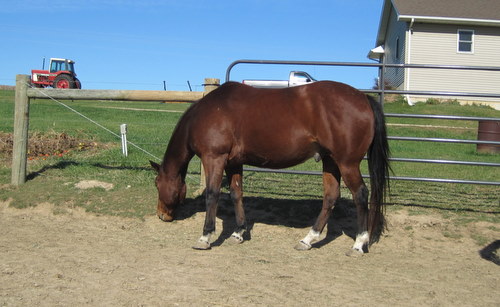 This is a pic of his neck from Oct. 3, it is about the same 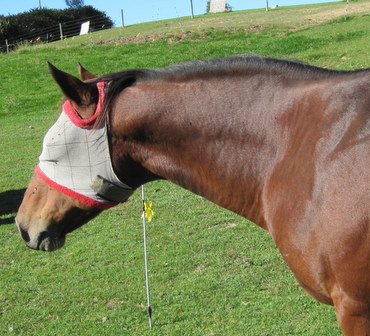 Flash, I am not aware how long it would take thyroid meds to work, but she seems much spunkier, looks much better, and walks better  These may be one of those temporal events, so we'll see how that plays out...her neck even looks a little better These may be one of those temporal events, so we'll see how that plays out...her neck even looks a little better She weighed in at #794's. The leg she is weighting in front as she walks is the twice bowed tendon leg, somehow that old broad managed to buck the odds again, her fetlock doen't even DrOp anymore... she has had a very slight limp off and on tho. Right now it is gone. Keeping/getting weight off her would be beneficial. She weighed in at #794's. The leg she is weighting in front as she walks is the twice bowed tendon leg, somehow that old broad managed to buck the odds again, her fetlock doen't even DrOp anymore... she has had a very slight limp off and on tho. Right now it is gone. Keeping/getting weight off her would be beneficial. 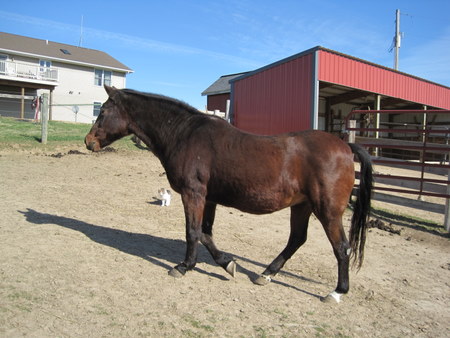 Sam, he is holding his own, he has his long hair going on, but is doing well otherwise. He weighed the same as Flash #794's. I can easily feel everyones ribs, I would like to very much keep it that way this winter! and maybe get rid of the residual IR look. 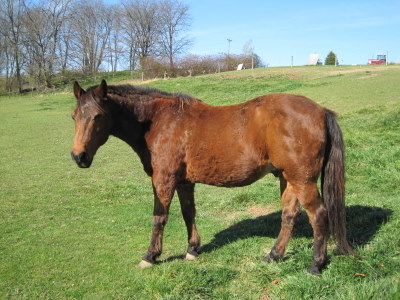
|
| Member: scooter |
Posted on Saturday, Nov 6, 2010 - 12:59 pm: Here's what I have about 11 days into the experiment. They are all getting a heaping scoop of the thyroid meds. Their diets remain pretty much the same, except I am not soaking their hay anymore and I am giving them a bit more at night since it is getting down in the lower 20's. Everything else including grazing has remained the same since I started the experiment.Hank weighed in at #988 Flash weighed in at #757 Sam weighed in at #744 Hank had me a bit worried the first couple days he seemed a bit hyper and our ride from above was VERY UP I have since ridden him a couple times and he was awesome! He is not hyper anymore and actually seems a little more subdued.... don't know what to make of that... but he isn't as nuts as he used to be...dunno how the meds would do that so may be one of those coincidences. Also oddly enough he doesn't seem like he is starved all the time.. I can see his ribs in the right light, would still like to see more weight DrOpped, his neck seems about the same, maybe a bit better, his butt lumps have disappeared. 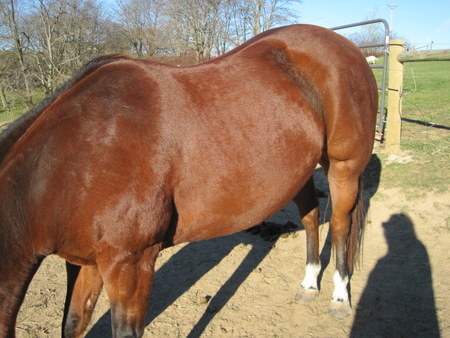 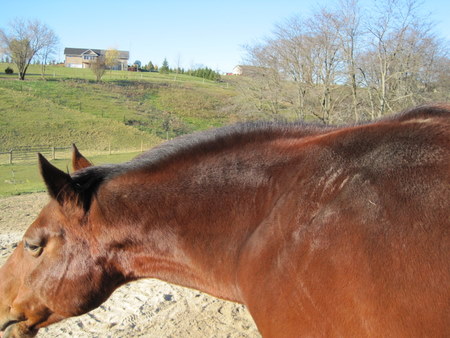 Sam has had the most drastic weight loss, I guess that's good since he is quite IR. He looks good and seems to feel good...removed the pergolide quite awhile ago about 6 weeks I think and still no return of PPID symptoms (other than his hair) But his hair is doing strange things now  He has these hairy dapples going on, his neck is about normal, his fat butt lumps are better, his thigh bumps are about gone. This shows his weird hairy dapples and really doesn't do them justice, all the horses are very dusty! It's been quite dry here. 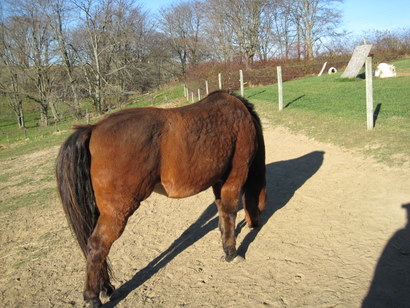 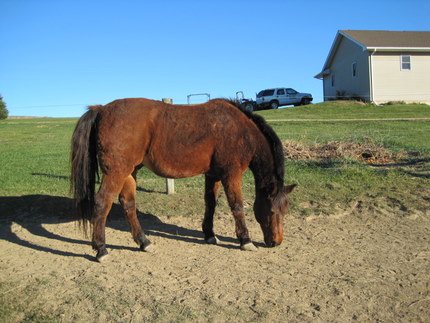 Flash really does seem to have perked up a bit. She is even fighting back when the boys play musical hay leafs. She has a little more spring in her step and doesn't seems as depressed or tired whatever it was. 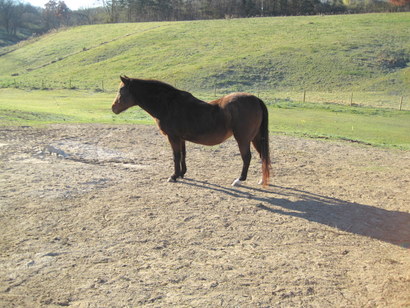 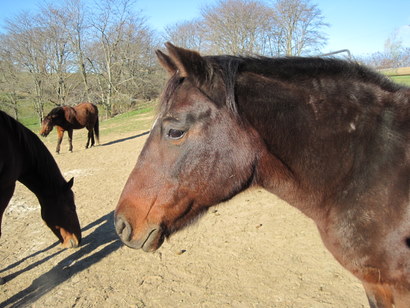 All 3 are as sound as they get 
|
| Member: gwenyth |
Posted on Thursday, Nov 11, 2010 - 9:08 am: Diane, this is all very interesting! Keep us updated...are they still losing weight?nancy |
| Member: scooter |
Posted on Thursday, Nov 11, 2010 - 4:11 pm: Thanks Nancy, it appears they are loosing weight slowly, they are now on 24/7 turnout on the grass too. Hanks on and off DP's have disappeared. Sam is VERY sound even with his ugly hooves . Flash seems more awake . Flash seems more awake I weigh them on the weekends with the tape, with the winter hair still coming on fast and furious I don't know how accurate it will be. Sam isn't growing his off color long cushings coat yet, I looked at my pics from last year and he started it right around now so will be curious how that plays out...He is VERY fluffy tho!! I weigh them on the weekends with the tape, with the winter hair still coming on fast and furious I don't know how accurate it will be. Sam isn't growing his off color long cushings coat yet, I looked at my pics from last year and he started it right around now so will be curious how that plays out...He is VERY fluffy tho!!
|
| Member: scooter |
Posted on Thursday, Nov 11, 2010 - 5:02 pm: Here's some video's of me TRYING to bring the horses off the big field. I am so proud of how Hank is moving, he is so loose and free. Sam was being a little negative about coming in . These 2 have been chronic founders with some moderate to major rotation!!! They are barefoot and can be ridden with no problem. . These 2 have been chronic founders with some moderate to major rotation!!! They are barefoot and can be ridden with no problem. The old mare, while her hocks don't bend the best, she is 31 yo. with a twice bowed tendon  So I think she looks darn good for an old broad. So I think she looks darn good for an old broad. The 2 EMS quite foundered boys (with the ugly hooves)  I think the HA folk, Dr.O. and my experiments have finally gotten the "kids" right! I think the HA folk, Dr.O. and my experiments have finally gotten the "kids" right! Hanks wonderful canter, it's a joy to ride, have to get the 2 boys together before they come in! https://picasaweb.google.com/hank97/TheKidsComingIn#5538411566427214482 Sam being a bit reluctant about the whole thing https://picasaweb.google.com/hank97/TheKidsComingIn#5538410809724290210 OK OK we get the hint. https://picasaweb.google.com/hank97/TheKidsComingIn#5538409467830180338 The matron bringing up the rear https://picasaweb.google.com/hank97/TheKidsComingIn#5538411936864054994 |
| Member: gwenyth |
Posted on Thursday, Nov 11, 2010 - 7:36 pm: Diane, Hank looks great! You can see that Sam is slightly tender at the trot, but at 27!!! he looks fab!Keep us informed!! nancy |
| Member: scooter |
Posted on Thursday, Nov 11, 2010 - 8:05 pm: Really, I didn't think Sam looked off at the trot, I did clean their hooves when they came in and Sam is shedding his frogs and they are quite tender looking.His trot is a trot from Hades, I have never ridden such a rough trot. It's one of the reasons I quit riding him  . He moves like a pony. His canter is nice and smooth tho. . He moves like a pony. His canter is nice and smooth tho. They all appear in good weight, I'll let you know how it progresses. |
| Member: frances |
Posted on Friday, Nov 12, 2010 - 5:22 am: Diane, they look really really good. You are to be congratulated for your good ideas and perseverance! |
| Member: scooter |
Posted on Friday, Nov 12, 2010 - 7:31 am: Thanks LL I forgot Hanks neck picture for the week, it does look a little better. 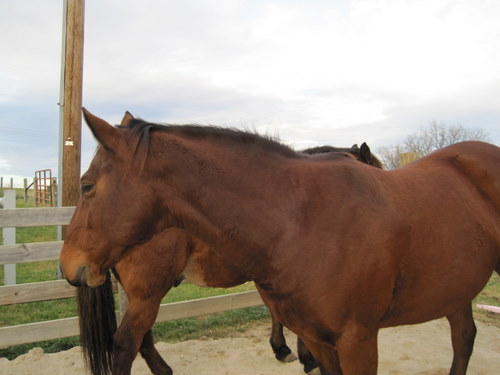 And my magnificent helpers (the slow down feeders)  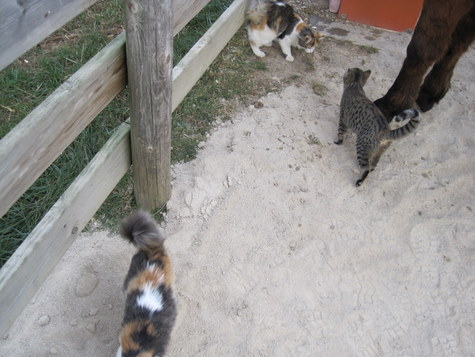
|
| Member: kpaint |
Posted on Friday, Nov 12, 2010 - 7:47 am: diane, what type of "thyroid meds" are you giving? |
| Member: scooter |
Posted on Friday, Nov 12, 2010 - 8:17 am: Vicki they are getting pala-tech thyroid supp, the same as thyro-l, just a different brand.I really didn't want to resort to this  , but if it helps me keep their weight down I guess it is worth it. I plan on "weaning" them off it come spring or after the spring grass is less lush, depends on if it helps or not. It seems to be, but I think it is a little to early to tell. , but if it helps me keep their weight down I guess it is worth it. I plan on "weaning" them off it come spring or after the spring grass is less lush, depends on if it helps or not. It seems to be, but I think it is a little to early to tell.
|
| Member: gwenyth |
Posted on Friday, Nov 12, 2010 - 8:38 am: Ah, Diane, I understand! His canter looked so good, that his trot was fooling me! lol!!But I bet if it is anything at all, it would be the frogs shedding.... he did not look "lame", just so different from that canter. The horses do look really really good!! nancy |
| Member: vickiann |
Posted on Friday, Nov 12, 2010 - 10:42 am: Interesting, Diane.Thanks for sharing this information. Perhaps I will discuss this with my Veterinarian when he comes out next month. With the acorn eating, Perry has put on fat pads again in all of the places you mentioned although his ribs are still somewhat visible and his overall weight hasn't risen greatly. |
| Member: scooter |
Posted on Friday, Nov 12, 2010 - 6:30 pm: Vicki those fat pads are very telling in my boys, if they start blowing up something has to change and quickly . . Just to be clear these guys are still being maintained on a low carb diet. I wish I could throw caution to the wind, but know better. I think Dr.O. has some information in his fat horse article about thyroid supplementation. I posted it in Sam's CD thread, from what I understand it can help with weight loss and insulin Resistance. The program being starting with a high dose and slowing weaning them off. Here is an excerpt from a very good article from vet med Treatment Equine metabolic synDrOme should be managed by reducing caloric intake in obese horses, decreasing the starch and sugar content of the diet, increasing exercise, and limiting or eliminating access to pasture. However, medical therapy becomes necessary when IR persists after management practices have been adjusted. Medical therapies also can be used as short-term interventions to accelerate weight loss or improve insulin sensitivity while management changes are being implemented. This approach reduces the likelihood of additional laminitis episodes occurring before management strategies have become effective. Levothyroxine sodium (Thyro L, LLOYD, Inc., Shenandoah, IA) can be administered to horses with EMS to accelerate weight loss and improve insulin sensitivity. Mean body weight decreased and insulin sensitivity increased when levothyroxine sodium was administered to healthy mares at dosages ranging from 24 to 96 mg/day over 8 weeks.46 Long-term effects of levothyroxine on body weight and insulin sensitivity also have been evaluated in healthy mares over a 48-week period.47,48 Levothyroxine sodium was administered to mares at a dosage of 48 mg/day, and glucose dynamics were measured at 0, 16, 32, and 48 weeks. Echocardiographic evaluations, complete blood count, and plasma biochemical analyses were also performed at the same times to assess the safety of levothyroxine. A greater than twofold increase in mean insulin sensitivity was detected, and this mirrored a reduction in body weight. No adverse health effects were detected. It is essential for horses to be placed on a controlled diet when levothyroxine is prescribed because weight loss is harder to achieve if the horse is permitted free access to pasture. Levothyroxine sodium is administered by mouth or in the feed at a dosage of 48 mg/day for 3 to 6 months to induce weight loss, which is equivalent to 4 teaspoons per day. Smaller ponies and Miniature horses can receive 24 mg levothyroxine sodium per day for the same time period. Treated horses should be weaned off levothyroxine sodium once ideal body weight has been attained by reducing the dosage to 2 teaspoons (24 mg) orally per day for 2 weeks and then 1 teaspoon (12 mg) orally per day for 2 weeks.48 Measured serum T4 concentrations are often elevated when levothyroxine is being administered, but concentrations vary considerably within and between horses. Serum T4 concentrations often range between 40 and 100 ng/mL in treated horses, indicating that levothyroxine sodium is being given at a supraphysiologic dosage. However, clinical signs of hyperthyroidism such as sweating or tachycardia have not been observed in treated horses.46,49,50 Benefits of treating horses with levothyroxine at lower dosages for longer periods have not been evaluated scientifically. However, it was recently demonstrated that administration of levothyroxine sodium at a dosage of 48 mg/day for 14 days prevented healthy mares from developing transient IR in response to the intravenous infusion of endotoxin.51 This finding suggests that levothyroxine exerts a protective effect on insulin sensitivity when horses are challenged with endotoxin. Insulin-sensitizing drugs including metformin and supplements such as chromium and magnesium are also being evaluated as treatments for IR in horses. Positive responses to metformin have recently been reported.52 This drug is available as Glucophage (Merck Santé S.A.S., Darmstadt, Germany) and is distributed in the United States by Bristol-Myers Squibb Company. In the aforementioned study, metformin was administered to insulin-resistant horses and ponies at a dosage of 15 mg/kg twice daily by mouth. Proxy measurements of insulin sensitivity improved in treated animals, without the adverse effect of hypoglycemia, but long-term results were variable. Metformin is a biguanide drug that enhances the action of insulin within tissues at the postreceptor level and inhibits gluconeogenesis within the liver. Results of this first clinical trial look promising, and metformin represents an option for the short-term management of leaner insulin-resistant horses. However, safety studies have not been performed to date in horses, so this must be considered before the drug is prescribed long-term. If you have a horse that you suspect or has EMS here is the link to the whole article, it's long, but a VERY good read. https://veterinarymedicine.dvm360.com/vetmed/ArticleStandard/Article/detail/62824 4 |
| Member: vickiann |
Posted on Friday, Nov 12, 2010 - 7:56 pm: Thanks, Diane.Important to know as we approach the time frame when Perry came down with laminitis in January. These fat pads seem very classic of a metabolic problem. I do NOT want a repeat of the problems that he began early this year. He has been doing so well but now these fat pads have reappeared just over the past 30 days. |
| Member: scooter |
Posted on Saturday, Nov 13, 2010 - 8:16 am: I know what you mean Vicki, I am doing everything I can to avoid last winters fiasco, I raked up the one million locust pods last weekend.Sam sounds very much like Perry, he isn't fat by any means, without his hair you can see his ribs easily, he does have the fat pads. Last year when he got sick they really blew up, even tho he was in good weight. I think it is a sign his diet is wrong and his IR is acting up, I watch them VERY closely.... The more his fat pads deflated last winter the better he got. I'm not sure what set his insulin off like that but something did. I should have been paying closer attention to them! |
| Member: vickiann |
Posted on Saturday, Nov 13, 2010 - 11:22 am: Good for you with the locust pods, Diane.The things we have to do to protect our horses! As I think this all over I am wondering if the significant re-arrival of fat pads on Perry has to do with more fructan in the pasture grass due to a long period of stressful DrOught conditions followed by a couple of rains rolled together with mostly cooler (especially nighttime) temperatures. |
| Member: scooter |
Posted on Saturday, Nov 13, 2010 - 11:38 am: Vicki I wouldn't doubt it was the grass. Sam and Hank have to stay off of it for a couple days after it rains, especially if it has been dry. We actually had that happen the last couple days and they are locked in the paddock!!! I am going to let them out for a few hours so they can move around, but once again I must "watch it" Nothings easy! But watching this stuff is much easier than dealing with founder! |
| Member: scooter |
Posted on Wednesday, Nov 17, 2010 - 8:06 pm: This experiment really has me questioning so may things about my horses. First off I decided to up their thyroid meds to "suggested" levels for weight loss...the 2 oldies being basically ponies and Hank just making horse status. They have been getting 24mg's instead. As far as weight loss with the tape, I can't go by that, too much hair coming on.According to LOOKs and bcs I would say they have lost some weight. It SEEMS to have had different effects on them. It really does seem to be keeping Hanks weight down, more so then the other 2. He WAS the fattest of the 3 of them also. His neck looks better, he looks better. His on again off again DP's still have not returned, morning check of them always brings a grin and a I'll be damned. He isn't anymore hyper than he ever has been. He is moving great, soft or hard ground. Sam.... this really confuses me and I could go on and on about his Cushings disease,pergolide, IR, and EMS, but will try to stay with the pertinent parts... and a FEW of my off the wall observations. I tried a stint with pergolide on Sam for about a year, according to "symptoms" he is definitely a Cushings horse. I decided to take Sam off pergolide about 2 mos. ago, It took great thought as I don't want Sam uncomfortable, but his EMS symptoms seem to be more of a problem then his PPID. He also didn't seem to tolerate it well. Pergolide does nothing for EMS. Recent research seems to point to Thyroid supplementation can and does. Sam is doing AWESOME, his PPID symptoms are NOT returning, He is galloping and looks good for an old codger. His cushings coat is NOT coming in still. He had a good start on it this time last year and the 8 years before. I don't know if this is the right spot to put this, but according to everything wrong with Sam he IS a PPID horse. The questions that go through my mind is WHY does he not get worse UNLESS I am lax with his diet. PPID is suppose to be a progressive disease. Sam has been hirsute (the one clinical sign considered a bell weather for PPID) for so long I can't remember how long it has actually been, I'm guessing 9-10 yrs. I know he was when we moved here about 8 yrs. ago. and I know I clipped him a few years before we moved here. Here's my conjecture as Dr.O. calls it. I am starting to suspect that Sam is not a PPID horse  Even tho his hirsutism would say he is. I think he is a terribly metabolic horse with PPID not being involved. I also think (I hope Dr.O. doesn't "yell" at me), that PPID is over diagnosed and mistaken for a VERY metabolic horse. Even if you read through some threads right here on HA some people had said once they got their horses diets right and their "weird fat" went away they shed out. I think the thyroid meds MAY help these terribly metabolic horses more so then pergolide. I think I stated in here a few times that my vet said if I could get Sam in good shape he would shed out. A couple years ago when he was in good shape he darn near did. My goal is to get Sam back into good shape and with the help of the thyroid meds keep his IR under control... and see if he will shed out at least enough that he doesn't break every clipper I try when shaving him. Other than that Sam is doing GREAT, happy, sound, rolling, muddy and enjoying life. He is in good weight BCS 5 some weird fat hanging on. The weird fat patches IS where his hair is much thicker...tis very strange...it is normal where there is no weird fat. Even tho his hirsutism would say he is. I think he is a terribly metabolic horse with PPID not being involved. I also think (I hope Dr.O. doesn't "yell" at me), that PPID is over diagnosed and mistaken for a VERY metabolic horse. Even if you read through some threads right here on HA some people had said once they got their horses diets right and their "weird fat" went away they shed out. I think the thyroid meds MAY help these terribly metabolic horses more so then pergolide. I think I stated in here a few times that my vet said if I could get Sam in good shape he would shed out. A couple years ago when he was in good shape he darn near did. My goal is to get Sam back into good shape and with the help of the thyroid meds keep his IR under control... and see if he will shed out at least enough that he doesn't break every clipper I try when shaving him. Other than that Sam is doing GREAT, happy, sound, rolling, muddy and enjoying life. He is in good weight BCS 5 some weird fat hanging on. The weird fat patches IS where his hair is much thicker...tis very strange...it is normal where there is no weird fat. Flash... She has come to life a bit, she always acted tired (maybe depressed) not sure. I was LMAO when I turned them out on the back hill tonight. She ALWAYS stays at the bottom of the hill, doesn't have the energy or the want to gallop like the nutty boys all over the place. The last few days she has been, throwing her head and having fun.. She is rolling in the mud again, and just seems more content and energetic. All of this stuff most definitely could be coincidences. Sam's cushings hair coming in Nov. last year. you can see it starting on his chest and side..the orange hair. 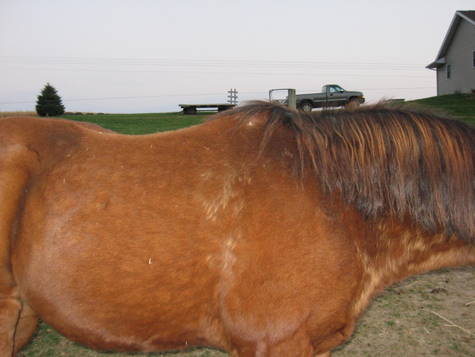 his hair the year before pic above.. Nov. (he looked bad!) Didn't have his diet tight enough. 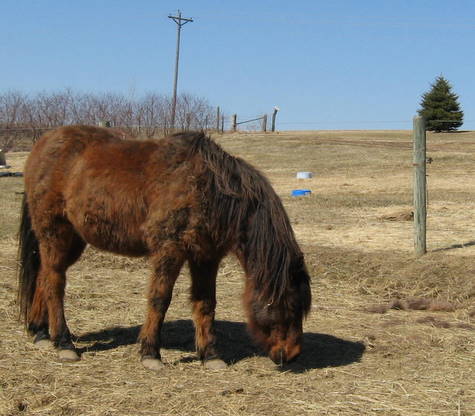 Sam tonight, he did roll earlier in the mud and I didn't brush him  . Not an orange long hair on his body, there has been every year at this time, sometimes worse then others. I searched high and low for a sign of his CD coat tonight and found nothing YET . Not an orange long hair on his body, there has been every year at this time, sometimes worse then others. I searched high and low for a sign of his CD coat tonight and found nothing YET 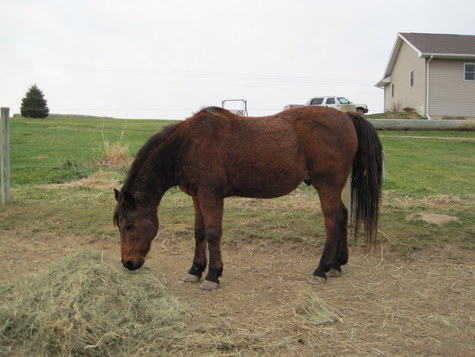 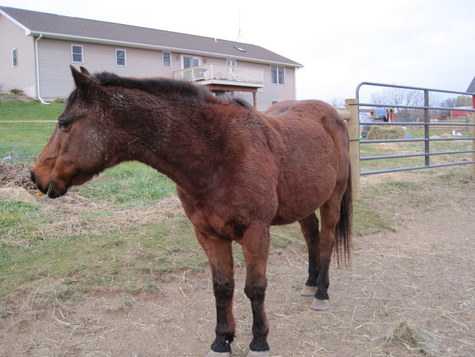
|
| Member: scooter |
Posted on Monday, Nov 29, 2010 - 9:01 am: A little over a month into this, the horses are all doing well. We decided to put a big bale in a few days ago, thought I would let them at it 24/7 didn't work I don't think. They really don't seem to eat much of it, but Hank seemed to get a tiny bit hoof sore on the frozen, rutted ground, don't know if it was coincidence or not, but not playing that game, so let them on it at night and let them look for food during the day, there is still a little pasture out there and they keep moving, important for these types. Once we have a good snow cover I may try it 24/7 again. They don't move much anyway once the ground has poor footing and I don't really like them to. Hank is back to being sound, his hooves were over packed with mud and lime and may have been the cause of his "tentativeness" he was fine once cleaned.It appears they are all losing a little weight, not massive amounts by any means, but slow but sure. Hank BCS is a low 6, his neck does look better I think. Flash and Sam BCS 5, Sam still hasn't had a reappearance of his PPID symptoms  His light orange cushings coat still isn't starting, he is quite hairy, more than he "should be" but at this point it seems like "normal" hair. He hasn't gotten a "laminitis ring" in his hoof since I started this. I think this does help him with his IR issues. His light orange cushings coat still isn't starting, he is quite hairy, more than he "should be" but at this point it seems like "normal" hair. He hasn't gotten a "laminitis ring" in his hoof since I started this. I think this does help him with his IR issues. I decided I am going to skip the ration balancer this winter and go with the high point grass from horse tech... less calories, less nsc's. It also has the prebiotics and probiotics since they are on a big bale and their square bales are less than ideal this year, figured it wouldn't hurt to keep the bowels working and additional vit/min. for easy keepers. So anyway so far so good! |
| Member: scooter |
Posted on Monday, Nov 29, 2010 - 10:01 am: I was a little off, when I let the horse out to pasture today I could SEE everyone's ribs They still have a slight covering of fat(PERFECT Weight for them), those winter coats are quite deceiving, even when feeling for ribs. They still have a slight covering of fat(PERFECT Weight for them), those winter coats are quite deceiving, even when feeling for ribs. Dr.O. if you read this what would your suggestion be to "hold" their weights??? Not sure what the protocol is  . Do I slowly start backing off the meds OR feed them more????? . Do I slowly start backing off the meds OR feed them more????? I hadn't planned on weaning them off until around Mar. I do have them on their continuous diet and their hay isn't the greatest. |
| Moderator: DrO |
Posted on Monday, Nov 29, 2010 - 1:23 pm: If horses are getting too thin and being given thyroid medication, discontinuing it over about a months time is certainly the first thing I would do.DrO |
| Member: scooter |
Posted on Monday, Nov 29, 2010 - 5:08 pm: Dr.O. considering their problems I don't think they are too thin, I would like to maintain this BCS.I think the thyroid meds are doing them all some good, especially with the IR issues. I maintain them on a fairly strict diet because of these issues. Would feeding them more hay, especially since winter is here, not make more sense then reducing the thyroid meds??? OR do you think this counter productive?? I have plenty of hay it just isn't the greatest (which they will plump up on also) I don't know if you read through the whole thread, but the purpose of this experiment is to be able to feed them "more normally" through our brutal winters. Would love your thoughts on this Thanks |
| Moderator: DrO |
Posted on Monday, Nov 29, 2010 - 6:44 pm: And you think feeding artificial hormones more normal than increasing the amount you have to feed?DrO |
| Member: scooter |
Posted on Monday, Nov 29, 2010 - 7:30 pm: I don't understand that statement Dr.O. If I don't feed the artificial hormones I can't increase their feed, in fact I would probably have to lower it.I do not feel maintaining them on 6#-10#'s of stemmy hay a day is normal or healthy either is it? Thanks |
| Member: ajudson1 |
Posted on Tuesday, Nov 30, 2010 - 7:14 am: Diane,I don't know if how horses respond to thyroid meds is the same as how people respond but having been on meds for Hyperthyroidism I can vouch that it is a very touchy problem to address. The smallest helpful dose is what you would want, IMO. Now, DrO may not agree with this as it's more "holistic" but IMO, and the opinion of many others, sometimes when we "fix" one area, another needs to be addressed. For example, in my case adrenal exhaustion caused my thyroid to go into overdrive trying to make up for what the adrenals weren't doing. Agree or disagree with that as you see fit, but I only had to take the thyroid meds on 2 different occasions, and as I addressed the adrenal problem the thyroid began functioning just fine. (not meaning to make this about ME, lol! Just an example) Can what I experienced apply to your horses? Is it possible that the short spell of hormones, weight loss, good hoof care, etc., has brought their bodies back into balance? Maybe just the extra fat they were carrying was causing the other body parts to work harder? (Kinda what came first the chicken or the egg ;-0) What if you slowly decrease the Thyroid med and watch their weights, then slowly increase the hay? Give it another month or 2? Do blood work to see what the TSH is and all those thyroid hormones...I assume it's the same in horses? T3 and T4 is it? Just my 2 cents of course. |
| Member: scooter |
Posted on Tuesday, Nov 30, 2010 - 7:33 am: Hi Angie, actually you hit the nail on the head, I always try to research this stuff before doing anything. I don't like to give my horses or myself meds.I did find scientific research that said horses that are IR for awhile can have low thyroid, it isn't a case of true hypothyroidism, it is caused by being IR. This is going by memory, don't have time to look for it right now, but it also said horses with PPID can have low functioning thyroids also. I do believe this is "balancing" them out. I am not using this as a band-aid to stop management as stated above, but hoping to get a handle on the IR/EMS symptoms that seem to hang on no matter what I do...short of literally starving them. With some thought, I decided this was the lesser of the 2 evils. "Starving" horses, can bring on some bad habits, and actually exuberate IR. I DO plan on weaning them off it in the spring and see where we stand. I like to check stuff like this out with Dr.O. in case I am thinking wrong...which has happened more than once!! |
| Member: ajudson1 |
Posted on Tuesday, Nov 30, 2010 - 7:59 am: Ah good, we are on the same page ;-). I almost didn't post as I hate putting something out there that might come across as sounding like it's about ME ME ME, lol! It's not and I don't know if it would apply to your case but then again I don't think animals are much different than people in this area.Having been down the road with regular docs pushing the drugs, and all the "other" kinds of docs, I agree that it's all about finding the balance. Funny; I trust DrO to point out if something is way off base more than some of the doctors I've been to, lol! |
| Moderator: DrO |
Posted on Tuesday, Nov 30, 2010 - 4:00 pm: Diane your post on Oct 10th states they get considerably more than 6 lbs of poor quality hay a day. And during times when the pasture grass is not lush it sounds like they have free access to forage, which I consider when ever a horse has access to pasture for more than 6 hours a day.DrO |
| Member: scooter |
Posted on Tuesday, Nov 30, 2010 - 4:32 pm: Dr.O I do give them more than 6-10#'s. The 6-10#'s is what I have to give them to loose/maintain weight. I do allow them to graze when I THINK it is safe...yet the weight never comes off, and the IR symptoms persist... weird fat patches, Bounding DP's accompanied by lines in the hoof and flaring, while my micro managing has become much easier and getting rid of the clover has really really helped and we all had a very good year!!! I can not exercise them much in the winter, which is key with Hank and Sam. There is no grazing in the winter, and the hay I have now isn't the greatest. My hope was to maintain what I have worked so hard for over the last couple years... and to maybe level them off at a BCS of 5. Without the thyroid meds they would have to be maintained by "starving" them in the winter.Am I being silly?? is this just a vicious circle and I'm "chasing my tail"? Don't think I haven't wondered  At this point I seem to have the rest of the year down pretty good, but winter brings it's own set of problems..quite often. Thanks, I appreciate your help/thoughts |
| Member: scooter |
Posted on Tuesday, Nov 30, 2010 - 4:34 pm: BTW I think you meant my Oct. 30 post?? I do soak their hay before we get frigid temps also, which is helpful. |
| Member: scooter |
Posted on Sunday, Dec 5, 2010 - 8:57 pm: About a week into the dreaded month of Dec. frozen rutted ground, tip toeing horses, snow, ice, frigid temps, starve or not to starve....that's how winter usually goes Sam pulling his I am going to die now stint last year. Sam pulling his I am going to die now stint last year. After much thought I decided to keep the thyroid supplementation the same for now, let them at the big bale 24/7... no pasture...snow. Though Hank and Sam do go out and paw for morsels occasionally. Sam has been off pergolide for over 2 mos. now, PPID symptoms still not returning. The boys were racing around today and having fun in the snow...so far so good, I love having them on a big bale, sure makes my life much easier. wind chills are suppose to be -16 tonight and I don't have to starve them. Their weight loss seems to have stabilized and they all seem to be in perfect weight...so far. 
|
| Member: scooter |
Posted on Friday, Dec 17, 2010 - 8:34 am: Well the horses continue on their thyroid supplementation, it's interesting that the more research that comes out it shows levothyroxine does help with IR and horses that hardly loose weight unless starved.Sam being my most interesting in the experiment. He obviously has PPID, yet he does much better on levothyroxine then he did pergolide. his reoccurring low grade laminitis has stopped occurring, so far any way. Absolutely none of his PPID symptoms have come back, not even his cushings coat, the lines in his hooves stopped exactly when I started this. His hooves are still a mess from his earlier continued laminitis attacks. I will try to take pics later today to show where the lines stopped. He is VERY sound, even hard ground doesn't bother him. I'm very curious to see if he sheds out and if he does wonder what that would implicate, but I am getting ahead of myself there! Hank and Flash are "holding there own" and so far are having a good winter. I have a big bale of pure grass hay out and leave them at it 24/7. they are not loosing or gaining weight and most definitely don't seem as starved as they always THOUGHT they were. They also get a cup of alfalfa pellets a day, the free choice minerals and salt and that is it. I will try to get pics of sams ugly hooves and the horses BSC later today. I think the levothyroxine helps Sam way more than the pergolide did which is interesting. I suppose that would implicate treating/mamging his IR plays a bigger factor in his health than treating the PPID symptoms, since the PPID symptoms have not returned with the removal of pergolide and the addition of levothyroxine. Pergolide did not agree with Sam and I did not see much improvement after the initial improvement, my options were to up his pergolide or try something else. It is so hard to decide whether the symptoms are from too much pergolide or not enough I decided to try the removal method first since it can always be added back if necessary. While I understand that pergolide can and does help some horses, I also felt that it is a powerful drug that effects horses differently and can have some undesirable side effects, which Sam was experiencing. Hank is a little nuts, but he always is, so I don't know if it is his normal nuts or not. He needs exercise and I do not do anything much with the horses in the winter. He always has too much energy, but has been well behaved when handling him and working around him. If santa brings me a saddle (I Have been good this year!) I will get a ride or 2 on him and know for sure if it is normal nuts or more than normal nuts 
|
| Member: scooter |
Posted on Friday, Dec 17, 2010 - 8:39 am: Forgot I was going to add thishttps://www.thehorse.com/ViewArticle.aspx?ID=17396 |
| Member: lilo |
Posted on Friday, Dec 17, 2010 - 9:53 am: Diane - I am following this with interest, because of my mare. Fortunately, she does not (yet?) have any problems with her hooves - maybe that is the advantage of living in a dry climate.We have family in Montana that are into horses in a big way (members of the Back Country Horseman's Association). They have had problems with laminitis. This is their approach: horse into the dry lot, soak the hay, give bute and thyroid supplementation. I do not know which drug they are using, but obviously they have problems with lush pasture. My vet also seems to support Chromium supplementation for IR horses. Lilo |
| Member: scooter |
Posted on Friday, Dec 17, 2010 - 10:17 am: Thanks Lilo, sometimes I think I'm talking to myself...but that's ok, I do it all the time! I'm sure your dry weather helps you out, we face lush grass about 6 mos. of the year. With the clover removal the horses do tolerate grazing MUCH better, but I still try to be careful, seems after a rain it really gets dangerous for them so I lock them up for a few days in the dry lot.Prevention seems to be the key, not treatment after the fact, learning the "triggers" is very beneficial and INDIVIDUAL. I think I am finally getting a grip on all of this, it has been very challenging. I had no founders this year finally and the horses lived pretty "normally" for the most part...well there is still a couple weeks left  According to Sam's hooves tho he did have some low grade laminatic problems, and he did get a little ouchy a couple times, but nothing full blown. Since starting the thyroid meds and removing the pergolide he hasn't had an episode, fall, early winter is usually one of the times he does....last year being a doozy I don't want to revisit According to Sam's hooves tho he did have some low grade laminatic problems, and he did get a little ouchy a couple times, but nothing full blown. Since starting the thyroid meds and removing the pergolide he hasn't had an episode, fall, early winter is usually one of the times he does....last year being a doozy I don't want to revisit
|
| Member: scooter |
Posted on Friday, Dec 17, 2010 - 11:29 am: Here is pics of Hank..he was tired LOL, so his head was up for once! His neck is real close to normal, those of you that know what a blimp he is should see he is in good weight for him (even with the hair) His body seems to be loosing the IR look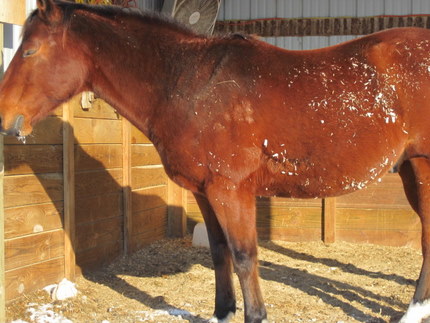 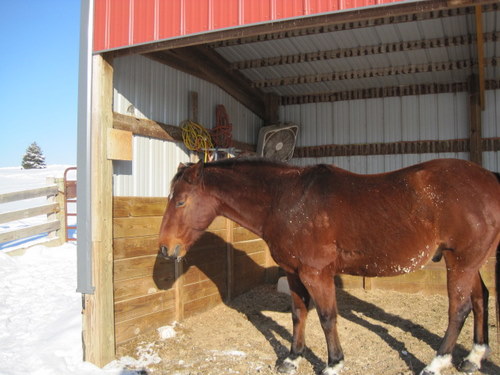 His hoof showing no founder rings for the year  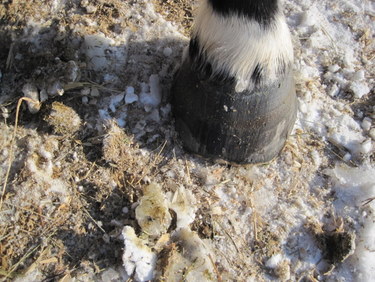 Sam He still has his dark coat..not the ugly, long, orange cushings coat! Pretty thick...but "normal" 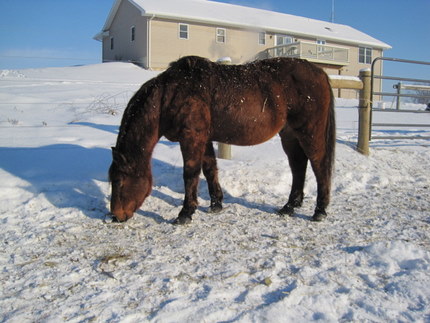 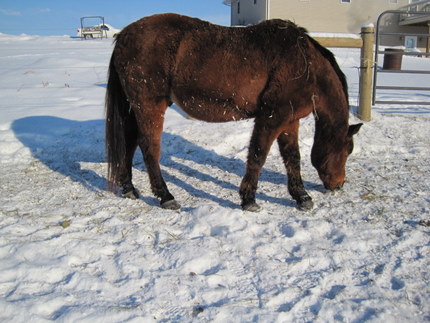 The top deep ring on his hoof is when I would assume I took him off pergolide and started the thyroid meds (the timing seems right)...around the end of Sept. he was weaned off pergolide. He had a snow ball in his hoof when I took this his hooves are bad tho. 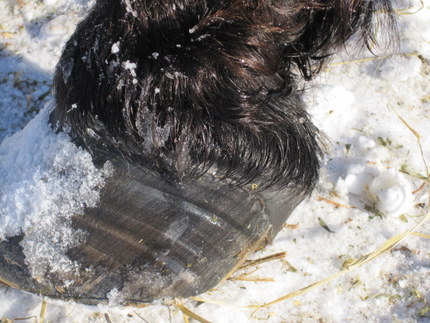 Old lady Flash..she is in VERY good weight, as sound as she gets. She had snowballs too! At least Hanks flat foot doesn't hold snow! there's a bright side to everything LOL 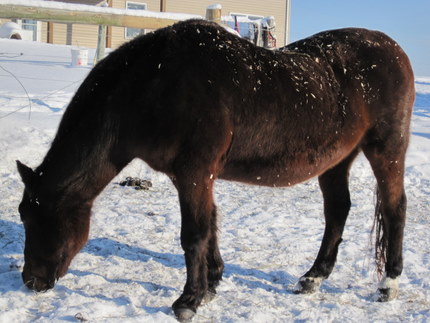
|
| Member: scooter |
Posted on Friday, Dec 17, 2010 - 11:45 am: I am not as nuts as my mom says! 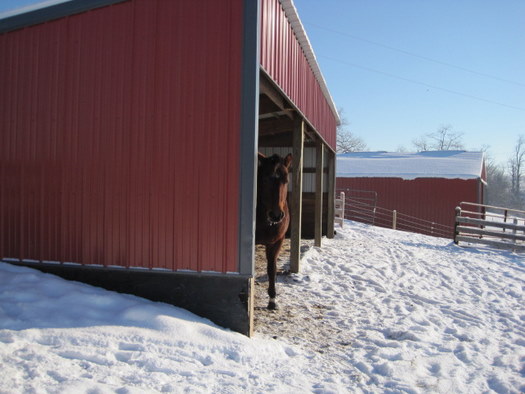
|
| Member: gwenyth |
Posted on Friday, Dec 17, 2010 - 12:19 pm: Diane, so interested in seeing those photos of Sam this year as VS last year - my husband just remarked this week that Feivel's coat was MUCH better this winter! It is thicker than the other coats, but a "normal" color and it's not the horrible matted hair of last winter. So he and Sam are very alike with this...What does of T4 are your horses on - still 24 mgs? That's what Feivel is on, but he is bigger than yours so I thought I might up him a bit if I see the need in the future. Right now he has NO goopy eyes, is active, and like yours, seems much less hungry. The other thing I can add to your "experiment" is what has happened to my other 2 "fatties" - they have been on Feivel's diet for the past 6-9 months, but I didn't add the T4 to them when I put him on it. The funny thing is that, since they were a bit IR (had tendencies but not too bad yet), they have also lost weight and seem less hungry! I also have hay out 24/7 in front of them, but it's low NSC hay, and they either aren't thrilled with the low sugar content, and hence eat less, and then maybe eating less sugar makes them less hungry..... I don't know... but I am hoping to stave off the IR from the younger ones. I thought by changing Feivel's diet in the spring of 2009 that I had done enough, but I guess it was NOT enough, since I still was not giving them minerals as I am now. I also think that making sure they have plenty of hay, but low NSC hay is working well for them. I think that diet is so crucial with these IR guys, but obviously the Thyroid is helping our "fatties" come into equilibrium. I only wish they still had the Eudamonic Thyroid powder - I used that for years with my old Cushing's horse and I liked it. but they don't make it anymore... Curious as to how long you intend to keep them on the Thyroid meds? Nancy |
| Member: scooter |
Posted on Friday, Dec 17, 2010 - 1:07 pm: Nancy I hope that Patty B. reads this as she had some interesting thoughts on her horse regarding hunger and IR. and I think she may have been on track. Did you see her thread about Ziggy a few years ago?I think Sam is a very metabolic horse, more so then the other 2, Hank is a close second and since he is younger, getting this under control may help him not to be doomed to PPID or other things in his twilight years. My horses big bale isn't great, they definitely don't attack it. It is clean and mold free so good enough! two years ago I tried giving them big bales and after a month the weight did start creeping up...very noticeably. It was much better LOOKING hay and I had to lock them off it during the night so they wouldn't get too fat. they never moved from that bale. I see hoof prints going out to the big pasture so they are staying mobile even with access to the big bale. hopefully Hank won't start his non-stop pawing for grass, his hooves take a beating when he does that. I think Sam is going to remain on his levothyroxine it really seems to help him with his IR issues.. he is on 24mgs. two scoops. I am very impressed how his top growth is coming in on his hooves, and how much his coat has improved. He did get the orange, long, cushings coat even on pergolide. His coat is better on the levothroxine...which is strange in itself! Hank and Flash I am going to play by ear, my vet thinks Hank should remain on it and if he isn't any more nutty than normal I think I will keep him on it too. Diet and exercise is the mainstay, but I sure am enjoying a little help 
|
| Member: gwenyth |
Posted on Friday, Dec 17, 2010 - 1:38 pm: No, I did not read about Ziggy and will look for the thread,I had Feivel on Thyro-L for about 3 years straight, and then I took him off it (slowly) to see if he did need it or not, if I got his diet straightened out. Weaned him off very slowly, and had him off it for about 18 months, until I put him back on. My husband insists that he needs to be on it - says he does better... I have read pros and cons about them staying on the drug permanently, and was wondering if your vet had any issues with them being on it forever. Had he ever experienced a horse with bone thinning due to it? Or any other complications? I'm considering keeping Feivel on it "forever", but since he is younger than Sam, I am in a quandary. If he was 25, I would just keep him on it 4ever, but at 20 I am not sure yet what to do. nancy |
| Member: scooter |
Posted on Friday, Dec 17, 2010 - 2:23 pm: Unfortunately every drug known to man/horse has risks, we must weigh the risk Vs. reward. We are not locked into continuing it's use and if the reward becomes less than the risk I will remove it.If I feel the IR issues have evened out, I may try weaning them off it. It seems protocol at the moment anyway is 6 mos. then try weaning them off. My vet called this morning with something regarding the cows and I told him Sam was still doing great with out the pergolide, he is determined Sam is going to founder badly again without it, he has moved it up to March now since Dec. is half over with no incidents.  The levothyroxine is not going to keep Sam from foundering NOR is pergolide unless my management is up to par.I think the levothyroxine just helps me beat the odds a bit and keep his insulin levels where they should be... time will tell as always! If I have any extra cash after Christmas I will check his insulin levels again. Here is a link to Patty's discussion it is under behavioral issues so you would probably have a hard time finding it! https://www.horseadvice.com/horse/messages/7/303404.html |
| Member: ajudson1 |
Posted on Saturday, Dec 18, 2010 - 9:57 am: Hank looks much better Diane!And boy do you have that right about the prevention. Ever since Tango gave me a scare once with some sore hoofies and pounding DP's I have taken the tough route of limiting pasture, keeping those hoofs tweaked, and trying to KEEP the weight off instead of having to take it off. I have been following this mainly because I have been wondering about my mare WIllow and whether she just has "old age" weight gain or if it's something more. You've given me some ideas for spring Vet questions. BTW, I get accused of talking to myself all time. My answer is I have to in order to talk to someone intelligent,  ;-). ;-).
|
| Member: vickiann |
Posted on Saturday, Dec 18, 2010 - 12:55 pm: This is really amazing, Diane! Thanks for sharing. |
| Member: scooter |
Posted on Sunday, Jan 2, 2011 - 3:03 pm: Well we made it through Dec. with no disasters . Waiting now to see if Sam will start shedding around the 3rd week of Jan. like the other 2. He has a "normal coat, but much Nothing like his thicker than Hanks and a little thicker than Flashes. . Waiting now to see if Sam will start shedding around the 3rd week of Jan. like the other 2. He has a "normal coat, but much Nothing like his thicker than Hanks and a little thicker than Flashes. They are on their last big bale for the year, I tell ya what an easy and cheap way to feed them during the bitter cold, my 3 are going to go through 2 big bales, one bale lasted them a month $25  If that would have been squares the cost would have been over $150 for a month!!!! quite a savings. If that would have been squares the cost would have been over $150 for a month!!!! quite a savings. They haven't lost anymore weight, seem to be holding their own. Once this bale is done it is time to get down to a little weight loss to get ready for spring and the worst of out bad weather should be behind us ( I HOPE). Sam is still the one that continues to amaze me on the levothyroxine, his hooves are still growing in well, no PPID symptoms have returned. he has rock crushers, ugly as they are. His teary eyes are gone (he had them year round) his mysterious back end lameness has seemed to resolved. Hank OTOH has been tippy toeing around a lot since the snow melted and the frozen rutted ground reappeared, hopefully it won't turn into anything serious. Flash is doing really well for an old lady. About a week ago her arthritis seemed to flare a little so I gave her a gram of bute and she has been fine since. Under all the hair I would put them at an average of 5.5 bcs. When I rode hank the other day I actually took the girth up 2 holes from where it usually is. The 2 oldies enjoying the smorgasbord 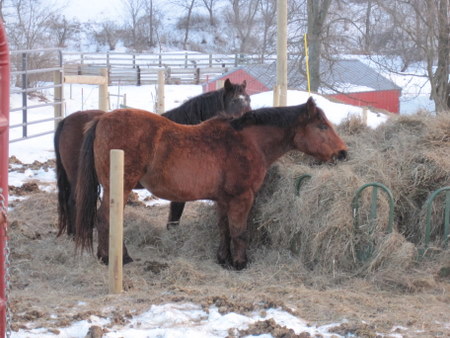 Hank 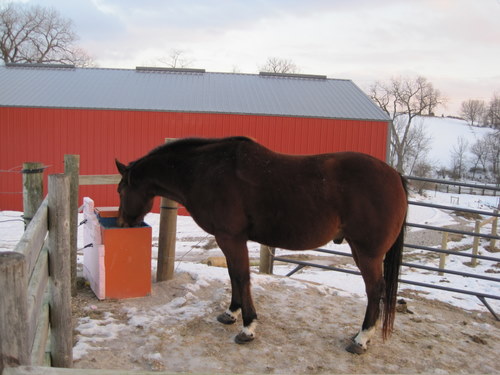 Flash with her best friend Frosty the calf, she lets the calf suck on her mane! 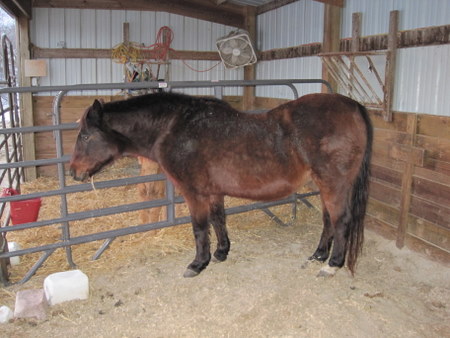 Close up of Sam's coat, little dusty, but normal, no cushings hair. 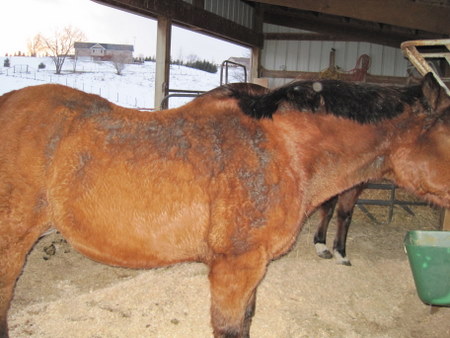
|
| Member: lilo |
Posted on Sunday, Jan 2, 2011 - 8:50 pm: Thanks for sharing the stories and photos. So far, so good. Keeping my fingers crossed for you.Is that thyroid medication expensive? Lilo |
| Member: scooter |
Posted on Monday, Jan 3, 2011 - 7:04 am: Thanks lilo,It runs about $20 a month for a tub... depends on the dosage. For one horse it probably would be around $10 a month. Hopefully next pics will be of Sam shedding! |
| Member: scooter |
Posted on Saturday, Jan 15, 2011 - 8:00 am: Middle of Jan. I remain impressed how well the horses are doing.I can feel ribs, they look and act good. The 2 older one really seem to benefit from it. Sam is handling the hard ground like it isn't there. He acts like a spunky arab as he should! He still hasn't gotten any more rings in his hoof. They are still quite ugly tho! His PPID symptoms remain under control, he seems quite normal  He loves to roll in the snow and mud, I have been so happy to see him do that, he had quit rolling while on pergolide and I found that a bad sign. Sam is on two scoops a day. I think Sam will remain on this. He loves to roll in the snow and mud, I have been so happy to see him do that, he had quit rolling while on pergolide and I found that a bad sign. Sam is on two scoops a day. I think Sam will remain on this. Flash is much more "with it" she doesn't stand around with her head hanging looking tired or depressed or whatever the problem was. She also is rolling again and keeping up with the boys pretty well. The other day hubby said why don't you feed them poor horses Flash is up on the big hill pawing(they have a big bale), I said no she isn't she never tramples through the snow to climb the hill in the snow. There she was  we both laughed when she came RUNNING down the hill with the boys. I do cringe a bit when she does stuff like that, but she seems fine and happy! Handling the cold, wet and upper midwest weather without any problems so far! Her weight seems good. She has her old lady body, but it seems to be working fine for now. we both laughed when she came RUNNING down the hill with the boys. I do cringe a bit when she does stuff like that, but she seems fine and happy! Handling the cold, wet and upper midwest weather without any problems so far! Her weight seems good. She has her old lady body, but it seems to be working fine for now. She is on a heaping scoop.. her and Sam would be considered ponies. I think she will remain on it too. Hank is holding his own as far as weight, I can feel his ribs, he looks good and healthy. He had a couple of days of sore feet when the ground turned hard and jagged, but got over it fairly quickly. His hooves are in good shape (for him) and the flaring and stretched WL really seems to be staying under control without my constant attention. He is on 2 scoops a day. I don't know if I will keep him on it since he is Much younger than the old cronies or not. I probably will try weaning him off it. He does get exercise and I can usually keep his EMS under control if he is exercised regularly. Their diets are free choice grass hay, a half cup of alfalfa pellets mixed with a handful of whole oats twice a day with a sprinkle of Iodized salt. Free choice minerals and a salt block. That's it for now. I have researched this further and found that older horses thyroids can get less active in their golden years. I don't have the research saved, but it was scientific  I will try to find it again later, and see what Dr.O. makes of it. |
| Member: lilo |
Posted on Saturday, Jan 15, 2011 - 9:53 am: Diane, I am so happy for you and your horses that this is working so well. I hope it continues!Lilo |
| Member: scooter |
Posted on Saturday, Jan 15, 2011 - 10:23 am: Me too lilo I think I will have Sam's insulin tested again the end of the month and IF it is in normal range (which would be a miracle) I may wean them all off it and see where we stand. I think I will have Sam's insulin tested again the end of the month and IF it is in normal range (which would be a miracle) I may wean them all off it and see where we stand.
|
| Member: frances |
Posted on Sunday, Jan 16, 2011 - 6:57 am: Very interesting DianE and congratulations! Thanks for keeping us in the picture. |
| Member: gwenyth |
Posted on Sunday, Jan 16, 2011 - 2:50 pm: Diane, just wanted to tell you that a week ago I noticed that Feivel was rolling in the mud like crazy - I realized that he had completely quit rolling last summer.... and is now back to his "old ways" of rubbing his forehead in the grass, over and over.... I about fell over when you said that Sam had quit rolling on the perg - is this all coincidental? Also, Feivel's PPID symptoms are in check as well, he no longer has to go immediately to the water trough after getting his timothy pellets - it's pretty noticeable.What are your free choice minerals that you feed? nancy |
| Member: scooter |
Posted on Sunday, Jan 16, 2011 - 3:27 pm: Right now I am just giving them the harvest salt, they don't really start touching the stuff until around March... dunno why.https://www.buckeyenutrition.com/media/137858/buckeye%20harvest%20salt%20loose.pd f It does seem as if Feivel and Sam are much the same. Sam loves to roll in anything he can find...especially mud! He had quit and while I didn't miss trying to keep him clean, it made me sad that he didn't feel good enough to roll and really was a red herring. He really didn't feel well or act/look right when on pergolide, hopefully we won't have to resort to it again. |
| Member: kpaint |
Posted on Sunday, Jan 16, 2011 - 4:46 pm: Diane, what thyroid supplements are you giving? |
| Member: scooter |
Posted on Sunday, Jan 16, 2011 - 5:49 pm: Vicki you asked me further up They are getting levothyroxine. They are getting levothyroxine. As Dr.O. called it an artificial hormone  same as people/ dogs/cats take for low functioning thyroid. same as people/ dogs/cats take for low functioning thyroid.
|
| Moderator: DrO |
Posted on Monday, Jan 17, 2011 - 3:54 pm: Hmmm a better term would be synthetic, that is it is manufactured but in the levo (left hand) chiral form I think it is a exact copy of the natural product.DrO |
| Member: scooter |
Posted on Tuesday, Jan 18, 2011 - 8:05 am: Well that sounds better than artificial hormone . I didn't think it was "artificial" but took your word for it . I didn't think it was "artificial" but took your word for it Whatever it is, it is working  Here is the paper I found that states older horses thyroid's slow down a bit...4th paragraph. The funny thing about Sam is he does/did show most every symptom of a thyrodectized horse, if he sheds it will make me wonder. https://wvc.omnibooksonline.com/data/papers/2010_V407_V408.pdf |
| Member: scooter |
Posted on Friday, Jan 21, 2011 - 8:46 am: SO it is minus 17 and the windchill is 32 below. The older horses and Hank were waiting at the gate for their food covered from head to tail in frost. Whinnying, bucking, rearing ect. even with their stilts on. They all had 2 inch ice balls in their hooves, I had to knock them out with a hammer they were so hard, and that wasn't easy!Cold intolerance isn't there, they were all sound when the ice balls were removed (very frozen hard ground) Sam is doing awesome  I am now torn whether I should slowly remove the levothyroxine or leave them on it, 6 mos. will be up in March. It sure is nice to have "normal" horses, BUT would they be normal without it??? I am now torn whether I should slowly remove the levothyroxine or leave them on it, 6 mos. will be up in March. It sure is nice to have "normal" horses, BUT would they be normal without it??? They are getting free choice grass hay and "holding their own", and a pittance of alfalfa pellets for hard feed. |
| New Member: briggai |
Posted on Friday, Jan 21, 2011 - 2:33 pm: Hello! I'm new here and thrilled about finding this site!WOW.This is all so helpful to me.I am dealing with a 15yr. old saddlebred gelding with EMS. He comes down with laminitis just about every winter.Last year was a bad one. In order to try to avert that this winter, I put him on magnesium/chromium supplements,switched to a low carb/sugaer feed,Purina Healthy Edge,and still he's come down with it again! I'm starting on Thyro L today in hopes of getting some weight off him and possibly avoiding this in the future!He has lots of tail head fat, is sluggish, lazy and wants to eat all the time! I want to thank all of you for the info. your putting out here!It's all so interesting/enlighting and I don't feel quite as lonely with this responsibility since reading of some of your problems with the same! Thanks again! |
| Member: gwenyth |
Posted on Friday, Jan 21, 2011 - 3:22 pm: Gail, nice to hear from you and we all hope we can help you with your gelding. Lots of us have been down the road that you are on - lol!Might I make a suggestion - please consider taking your horse off the Purina Healthy Edge - if he is indeed heavy, he doesn't need any carbohydrates, and the carbs in that could be contributing to the laminitis (who knows, right?) If you are worried about making sure he has enough vitamins and minerals, you can feed a handful of beet pulp (hydrated) or some timothy pellets and mix a vit/mineral supplement in with them. Since in all reality, there are lots of triggers that can cause laminitis in these horses, but removing the feed will help., even though it's "low carb, low sugar" it may still be too much for him. Another thing to do is to put your hay into what's known as "small mesh hay feeders", you can find them online at Chick's discount saddlery as well as Miller Harness co. This will "trickle feed" your horse , as he will not be able to eat his hay as rapidly, thus stabilizing his insulin levels. Also,that way you can keep hay in front of him more of the time, and the constant access to hay will also keep his insulin level in check. Some people soak their hay to remove excess sugars in the hay, and these nets make that more feasible, though I have never soaked hay. PLease be sure to go to the Horse Advice areas as to how to deal with laminitis, and EMS and Thyroid - Dr. O's knowledge and explanations are very thorough and can help you alot. There are other lists online with other info about EMS, but Dr. O backs his up with scientific journals and keeps abreast of recent scientific data. Good luck with your gelding! nancy |
| Member: scooter |
Posted on Friday, Jan 21, 2011 - 6:50 pm: Hi gail welcome to the world of EMS. I have struggled with this for YEARS. I want to reiterate that thyroid supplementation is not a substitute for managing these guys, not a magic bullet by any means , I maintain my horses on a low carb diet, they only get a handful of alfalfa pellets for "hard feed" and the same for treats! Their grazing is monitored very closely and exercise if possible is VERY important. , I maintain my horses on a low carb diet, they only get a handful of alfalfa pellets for "hard feed" and the same for treats! Their grazing is monitored very closely and exercise if possible is VERY important. I have/had a problems with winter laminitis also.. well laminitis pretty much year round, Sam had a VERY bad bout last winter. I am trying at this point to let them live semi normally out of the dry lot. A lot of trial an error I have had! It seems the research shows that thyroid supplementation can help regulate insulin, but remember that no drug comes without risks and you should discuss it with your vet. Dr O's articles are very good, my struggles are in all of them from founder to fat horse diets...I am slowly learning tho! Good Luck with your horse |
| Member: silver |
Posted on Saturday, Jan 22, 2011 - 6:39 am: DianE this is really interesting, thanks for posting!!!!You've seen the portly waist line of my monkey - everyone else (including my mini shetland) is DrOpping weight now apart from her - and mini doesn't do any "work" (lunged occasionally and does ground work for manners, but otherwise a lawnmower!) and she is out 3-4 times a week and it just isnt shifting. Starving her in summer was the only way I have got her weight down... They are out on 1.5acres short pasture (mostly dead thanks to snow!), 24/7 at the moment, but summer time they are on a "mud patch" with weighed out hay. Its so frustrating. Off to look at the herbal places I use to see if they do anything similar? |
| New Member: briggai |
Posted on Saturday, Jan 22, 2011 - 7:00 am: Hello, Diane! Thanks for your concern.I've have followed your expierment with a great deal of interest. I have started the thyro with the approval of my vet as well as my cousin who is an equine DVM.I've been dealing with this for about 7 years now with Butch getting an attack at least 4 of the last 7 winters. Years ago, I put him on Thyro and then took him off of it because he seemed to get a little "hot". No one told me at the time that I may need to just adjust his dose! He's basically been drylot all these years. It's a small pasture with nothing to speak of for grazing.We feed grass/brome hay. I'm going to take him off the small amount of feed he gets in exchange for something more suitable that I can mix some med or supplements on. Can you girls tell me what kind of minerals you offer to your horses? We have a salt block and mineral block out but they don't touch the mineral block. I've got to get this horse turned around. Last winters episode was terrible. All four feet and it lasted approx. 10 weeks! It was terrible. So far, it's not as bad this time and the bute does help. How long do you think it will be before I see a difference with the Thyro supplementation? BTW does anyone else have problems with this posting area? I cannot see what I've typed and it takes several minutes before it will show up?I'm starting him out on 1 1/2 tsp.per day of the Thyro. |
| Member: scooter |
Posted on Saturday, Jan 22, 2011 - 8:29 am: Gail I do understand your frustration more than you know. The levothyroxine is not going to make your horse become not sore. It is an addition to low carb diet, when diet alone doesn't seem to get them where they need to be.Last year a few of us had winter founders, I don''t know what caused Sam's for sure, he foundered badly in all 4 also I thought he was a goner and so did the vet. There are so many things, if your horse doesn't founder in the warmer mos. is it possible he has thin soles and can't tolerate hard ground? (if you have hard ground) Hank is like that  He got a little foot sore twice this winter when the ground was hard and jagged. He got a little foot sore twice this winter when the ground was hard and jagged. PREVENTION is the key here. I monitor Hank closely in the winter, try to keep his hoof optimal (for him)  If he starts tippy toeing and doesn't seem to get over it, I locked him on soft shavings until he did get over it. It really didn't take long at all this year thankfully. If his DP's are kabooming something has to change for sure! We did not get to this point this year. If he starts tippy toeing and doesn't seem to get over it, I locked him on soft shavings until he did get over it. It really didn't take long at all this year thankfully. If his DP's are kabooming something has to change for sure! We did not get to this point this year. Do you have any boots or anything to protect your horses soles until he can recover? One thing I learned if they are on bute and keep moving around because they feel better from it more damage can and probably will be done. Learned that the hard way! FME with winter founder or any founder, with these types is to get their carbs as low as possible (can you soak his hay) that would probably help a lot, get him off hard feed (alfalfa pellets or timothy pellets) and not much. I soak mine so they poof up and add the meds, they love them. Winter grass has brought on a dandy founder with Hank, so would avoid that if possible. Removing the clover from my pasture was truly the best thing I ever did. So you see I have done just about everything in my power to keep them from foundering with out the levothyroxine, and it worked last year  I won't say it was easy! Very careful monitoring of DP's and weight, observation of what sets them off... that list is fairly long LOL. BUT avoidance of this stuff has finally got them out of they dry lot and fairly "normal" with no laminitis last year. (after Sam's winter founder) I won't say it was easy! Very careful monitoring of DP's and weight, observation of what sets them off... that list is fairly long LOL. BUT avoidance of this stuff has finally got them out of they dry lot and fairly "normal" with no laminitis last year. (after Sam's winter founder) The levothyroxine is just a small addition to my program and that was more to try to level out their insulin resistance, I do believe it helped ALONG with careful management and observation. Dr.O.'s article on EMS and IR is very good.I live by it, with a few twists. Let us know how it goes with your horse. 
|
| Member: gwenyth |
Posted on Saturday, Jan 22, 2011 - 11:22 am: Gail, I think there is a reason that your horses aren't touching the mineral block, they really aren't formulated for horses, and they also have iron in them, and for an EMS horse, you don't want to give them any extra iron if you can help it. Supplements I have used include Source HF (which might be good for his feet) Source regular, Hoof assist, and there are others out there. be sure to get a supplement with adequate Copper and ZincBe sure to offer them free choice white salt in granular form this time of year, or add it to their feed, the salt blacks are often too hard this time of year for them to lick to get enough of. I agree with Diane about the boots and to take him off the bute as soon as you have him stabilized, you might try MSM instead as an anti-inflammatory. if you do not know your NSC of your hat, then soaking it is probably warranted (though in the winter I do not know if that would be possible) I agree totally that prevention is the issue - feed low carb but do not starve him - that will only make the situation worse, starving him will put the horse into stress which causes cortisol to increase, which will make the laminitis worse. You need to get your horse's weight down, and this will reduce his insulin resistance, which in turn will reduce your incidence of laminitis - we hope.... I have successfully tried APF, which is supposed to help regulate the adrenal glands, it may or may not work for your horse. There is the possibility that the cold weather itself may cause the foot soreness - there is recent evidence out that horses that have had laminitis before just can't handle the cold weather, as the "normal" shunting of blood away from the foot in very cold weather is very hard on horses that already have compromised laminae and circulation in the feet. As far as posting, you should see what you are typing and then should see a preview of the post before you do so..... nancy |
| Member: kpaint |
Posted on Saturday, Jan 22, 2011 - 11:57 am: Gail, you asked what minerals we feed.My horses (QH/Paint and 2 Haflingers) receive ADM Alliance Nutrition brand, 'Moorman's GroStrong Minerals for Horses'. I measure these loose minerals by the oz and feed according to directions on the bag. 1-2 oz daily. My horses' work load is very light at this time. I feed Buckeye brand 'Gro n Win" pellet feed (non alfalfa). I mix one cup of feed with 2 oz Cocosoya oil and the minerals once a day for my easy keeping Haflingers. The QH/Paint mare 2 cups feed with the oil and minerals 2x a day. I have noticed better coat, manes/tails, and hoof horn with this diet. I added the oil to the feed for a while then added the minerals...I believe the minerals made the greatest improvement. that's my regimen at this time with the current work load FWIW. |
| New Member: briggai |
Posted on Saturday, Jan 22, 2011 - 12:03 pm: Yes, I do realize that the thyroid supp. is not going to change the sore feet at this time. I'm hoping to get a little weight off of him, which should help. Also, I will take him off the feed and give the pellets you suggested such as timothy. How much do you give your horses? I feed twice per day.I will see about a mesh hay bag, good suggestion, Nancy! He is in a stall with shavings and has a small turnout paddock within the barn area. If boots would be helpful, I will look into that. Thanks ladies for your suggestions! |
| Member: scooter |
Posted on Saturday, Jan 22, 2011 - 12:15 pm: I agree with Nancy, I have been trying the KISS method tho. Right now my horses aren't getting any supplements, not even a vit. supplement . The main reason being my pocketbook! Everyone is doing great...so far. . The main reason being my pocketbook! Everyone is doing great...so far. I have no big triggers for them in the winter here tho. snow covers the grass, as long as they don't show any symptoms I let them paw through the snow for morsels. They seem fine with that this year, but for the most part there has been a lot of snow and they have to paw for a half an hour before they find grass! Hank foundered in a winter where there was no snow cover and I hadn't eliminated the clover at that time. I am going to put them on some supplements for spring, whether it's a waste of money I honestly don't know, but I am trying to stay up with the latest research on the subject and it would seem short-chain fructo-oligosaccharides may help with these guys. I also am going to put them on a Mg supplement for the "risky time of year", and salt is important too IMHO. You don't seem to have a problem with other times of the year other than winter? If that is the case I would look into protection from the hard ground. My problem is pretty much year round  unless I literally starve them or used to be anyway! unless I literally starve them or used to be anyway! Right now I just have harvest salt out for them, they don't really touch it much in the winter, about March it starts disappearing fast and they start biting the salt block off... dunno why! I have my theories, but that is what they are theories LOL. |
| Member: scooter |
Posted on Saturday, Jan 22, 2011 - 12:28 pm: Gail I had really good luck with the easy boot RX, as long as you get the right size they are easy on and off. I hand walked them in them as long as they weren't painful. They made Hank and Sam quite comfortable.If you can possibly soak your hay for half an hour or better that would help too (pour the water off). When it was cold I had one of those heated muck buckets and used that... a pain but well worth it. Sam started to get much better very quickly once I started doing that. It does reduce the carbs, and they seem to like it. Unfortunately until he started getting better I really cut him back and only gave him soaked hay and a handful of alfalfa pellets....his insulin was very high for some reason... we haven't looked back since then! I soak their hay in the non-frozen months now too, I don't know if they need it, but can't hurt  I think the levothyroxine probably works fairly quickly on their system. |
| Member: gwenyth |
Posted on Saturday, Jan 22, 2011 - 12:33 pm: Gail,as far as amount of timothy pellets, in your case I would not feed a large amount - maybe a cup per feeding until you get the weight off. It depends on how much protein your horses are getting from their hay - if not very much, add a few more timothy pellets. if they are not used to them I would add water with the pellets and minerals. My horses love them - though I am sure they would prefer a sweeter feed, they have done super on this. Not only does cutting out a feed pellet cut down on weight, but it also cuts down on inflammation, or so I have read. All the barefoot sites dealing with hoof form and hoofcare suggest that most horse feeds that have added carbs or soy might cause the hoof integrity to be compromised. I don't know the science behind this, but I do know that since I have removed grain products of all types from my IR/EMS horses, their feet are greatly improved, even the ones who never had foot problems like laminitis. So it's something you might want to think about for your gelding - no grain products, ever. They Do get used to it, lol!! I agree with Vicki that the minerals will give you the greatest improvement. IMHO I think that adding oil might not be as advantageous as adding minerals, as I made a horse MORE insulin resistant when I added oil to her diet. Not that everyone will have the same experience, however. nancy |
| Member: gwenyth |
Posted on Saturday, Jan 22, 2011 - 12:39 pm: Yes, easy boot Rxs would be perfect for this situation. they tend to run small, I think? Has that been your experience, Diane?nancy |
| Member: scooter |
Posted on Saturday, Jan 22, 2011 - 12:45 pm: I tried oil too a few years ago, didn't work! Vicki's horses/ponies aren't IR though I don't think, and have never had problems with founder. |
| Member: scooter |
Posted on Saturday, Jan 22, 2011 - 12:51 pm: Yes I think they run a LITTLE small. I just rasped Sam's and Hanks toes off to make them fit LOL. They needed it anyway Those boots were the only ones that didn't trash their hooves ( I LOVE them), they seemed to stay very dry in them. I always sprinkled a little medicated gold bond powder in to help with that also + it made them slip on very easy 
|
| New Member: briggai |
Posted on Sunday, Jan 23, 2011 - 7:12 am: I may be able to get alfalfa pellets around here but I don't know about the timothy.I live in such a rural area.Not much around here.I have to drive and hour to get to a bigger town with some choices. When it's 6 to 18 degrees wouldn't hay just turn to icy shreds if soaked? |
| Member: scooter |
Posted on Sunday, Jan 23, 2011 - 7:54 am: Hi Gail, I live in the "sticks" too! I give mine alfalfa pellets, I personally like them better in this situation. They have a low glycemic value, but more protein. Alfalfa cubes would be ok too. I used to use them when I couldn't find pellets. I soaked both pellets or cubes, more to avoid choke then anything.When Sam foundered last winter it was well below zero, I thought his hay would freeze solid but it didn't, soaking it was the problem until I got the heated muck bucket... I REALLY think this will help you if you can do it  . I soaked his for a good hour and poured all the sugary juice off and rinsed it again! . I soaked his for a good hour and poured all the sugary juice off and rinsed it again! Of course you will have a big ice patch where you do that!!! I gave him 1.5% of what his Body weight SHOULD be per day. If it was REAL cold a little more. Sometimes split in 3 feedings sometimes 2 depending on my schedule. He got about a cup of watered down alfalfa pellets twice a day. Sam did go on a I don't want soaked hay strike once, but I told him that is it or nothing... he got over it! Of course you will have a big ice patch where you do that!!! I gave him 1.5% of what his Body weight SHOULD be per day. If it was REAL cold a little more. Sometimes split in 3 feedings sometimes 2 depending on my schedule. He got about a cup of watered down alfalfa pellets twice a day. Sam did go on a I don't want soaked hay strike once, but I told him that is it or nothing... he got over it! He will think you are starving him, but when they start feeling better you will find it is all worth it. Once his weight gets where you want it, you can re-evaluate his diet. I think Nancy is right "starving" them is counter productive. 1.5% of body weight isn't starving them, you do need to cut his carbs. When Hank went on his diet, I cut that boy a bunch 1% of what his BW should be, he wasn't happy but every pound he DrOpped the better he walked.... he lost almost #300's  As you can see I am very passionate about this, having lived through many devastating founders. You have to be a little tough and don't let them beg you into more food... it is well worth it! My horses do live pretty normal now, but first we had to get to a non-obese status. Let us know how your horse does. If you start your own thread you may get more responses. |
| Member: gwenyth |
Posted on Sunday, Jan 23, 2011 - 9:10 am: Gail, do start your own thread, you will get more responses that way I think.I have to drive 2 hours to get my timothy pellets, I am in a rural area too, so I have fed alfalfa in the past, and I agree with Diane, your horse could probably use the protein right now. I feed 2-3# of timothy per day per horse so they get their protein, plus feed some alfalfa hay, and neither of these things are you currently in the position to do. Later on, when he loses weight, you can readjust his diet - you'll find that for the rest of his life, you'll have to be constantly aware of his weight and diet, but once you get your "system", whatever works for you, it's not so overwhelming. Be sure to give him enough Magnesium to make a difference. I know some of these supplements recommend 5g per 250# body weight for the INITIAL few weeks, and then to cut back on it. I have found that feeding Mg does seem to help considerably. Soaking the hay is not easy, but do buy those hay nets and it really helps! I know it is frustrating to deal with COLD weather in a situation like this, and I understand!! Nancy |
| Member: scooter |
Posted on Sunday, Jan 23, 2011 - 12:04 pm: Gail here is the link to Hanks diet thread.. it's the last part, the first 2 parts are linked in the beginning of this one. Notice in part 1 he had boots on and was very obese. Once he lost weight you will see the boots are gone . I would have soaked his hay then if I knew better. I have done this since and it does help a lot, especially when they are "acute" . I would have soaked his hay then if I knew better. I have done this since and it does help a lot, especially when they are "acute" He had 8 degree rotation with some sinking in both fronts... just a little encouragement  https://www.horseadvice.com/horse/messages/3/282691.html What is your horses BCS? What do his hooves look like? this info would help. If you start your own thread pics would help also Good Luck 
|
| New Member: briggai |
Posted on Monday, Jan 24, 2011 - 11:54 am: Nancy & Diane,Hello!You are giving me so much helpful information.I'm trying to sort and retain it all. Nancy, I was a little confused by your first paragraph. Did you mean that alfalfa pellets would probably be fine for Butch, in a small amount, like a cupful per feeding? I am giving him 10,0000 mg. of magnesium per day,this includes 2.5 mg.of chromium.Is this enough? Diane, I am gonna go back and look again at the BCS chart.I read it once but was confused because, the category that he seemed to fit into cannot see the ribs, but before his heavy winter coat put on,I could see his ribs! At the same time he has alot of tailhead fat, and other fat pockets on him. He is probably 15.1H and I'm guessing weighs probably a good 1100 lbs. There again, I'm guessing. I starting researching this Metabolic thing months ago,and was hoping that I could avert this winter episode. Apparently, I did not know enough! That's quite evident now! He's doing okay.Last year it was so bad,his eyes were so glazed with pain.Not this time, I don't see those glazed eyes. He is fairly quick to move into his feed position morning and nite and also to the water,even tho,it's stiffly. I gave him only one dose of Bute yesterday,and one the day before.I did not give him any this morning.I'm going out to the barn shortly to see how he is doing without it today. Our horses do not get sugary treats and prior to switching to the "low carb/sugar Purina feed, we fed a good brand of senior pelleted feed, but no more than like 3 lbs.per day divided. We always have gave them a goodly amount of grass/brome hay and there small pasture has next to nothing growing in it and never has! We were short on the square bales we put up this year, so my husband has insisted that if I don't pitch fork hay to them from a round bale, that we are going to run out of the squares.My problem is that I can't judge how much i'm giving them with the pitchfork. Not to mention the fact that I HATE to do that because it's so hard to get it raked off that round bale and very time consuming! I don't know if I can afford boots for him. I check that out today but you were saying something about styrofoam pads? Any more info. you'd like to share on those? Thanks again, ladies! Hope you have a wonderful day! I live in northwest corner of Missouri. |
| Member: scooter |
Posted on Monday, Jan 24, 2011 - 4:08 pm: A cup of alfalfa pellets twice a day would be fine for him. If you add about a half cup of water to them and let them sit for an hour or so they poof up and adding supplements/meds is easy and they mix right in. I put water in mine right after I feed them then they are ready for the next feeding.Gail do you know if you are dealing with actual founder, or bruised soles from hard ground? The reason I ask is FME the styrofoam is too hard for bruised soles and doesn't help. IF he is rotating styrofoam (construction grade) works very well  I have found for bruised soles and even founder that a garden kneeling pad cut to hoof size and duct taped on helps quite a bit. They have to be changed out almost everyday USUALLY because of compression. It would be a cheap thing to start with. I couldn't find any for Sam last year at wally world but did find some at the local hardware store. This is what I got for Sam until I got his boots..he liked these as well as his boots for comfort...maybe better. https://www.amazon.com/gp/product/B000RFS9G0/ref=pd_lpo_k2_dp_sr_2?pf_rd_p=486539 851&pf_rd_s=lpo-top-stripe-1&pf_rd_t=201& Cut them to size, wrap with vet wrap, finish up with duct tape. Pain in the arse, but to see him comfortable and walk :right" it was worth it! You can get about 4 pads from one cushion. I have heard these work also, but have never tried them https://www.matsmatsmats.com/exercise/fitness-mat.html There is also the hoof wraps they are around $18 a piece, and come with pads https://hoofwraps.us/product_info.php?products_id=1&osCsid=50ac09ba1a8191c89181c5 7d1859934b In the long run easy boot RX's are a better investment than the hoof wraps, they last MUCH MUCH longer and are easier to apply 
|
| Member: scooter |
Posted on Monday, Jan 24, 2011 - 7:16 pm: BTW Gail I have dealt with peeling the round bales too.. it is a pain! However I DID figure out an easy way to figure out how much I was feeding.. it isn't exact, but will give you a close idea. I got a big box, put it on a kitchen scale, zeroed it out an filled it with their alloted amount of hay... per weight. I found a box that fit the hay I wanted and filled that daily, it actually works pretty good, fill the box with the daily ration and feed out of that. So in your case if you believe your horse should weigh #1000's fill the box with 10- 15 lbs. of hay and you are done for the day you can even get days ahead with extra boxes. you can even get days ahead with extra boxes.
|
| Member: cheryl |
Posted on Tuesday, Jan 25, 2011 - 8:37 am: Gail - how do you have your round bail sitting? Is it on the side or sitting on the bottom? If it's sitting on the bottom the hay should just peal off in layers - just like it was baled. I weigh my horses hay with a spring scale which is hanging from a rafter near the round bale I'm feeding from. I use a small tarp with ropes tied to the four corners so when it's picked up the ropes hang on the scale hook. As soon as I feed - I refill the tarps for the next feeding - Just takes a couple minutes.Diane I've been following your experiment with great interest - I'm wondering if when Fox was getting Thyro-l if she wasn't getting enough - She was only getting one scoop - She's just a tad over 16 hands and should weigh around 1000 pounds. I really appreciate all the record keeping and reporting you do - it is so helpful. |
| Member: gwenyth |
Posted on Tuesday, Jan 25, 2011 - 10:56 am: Sorry, Gail, I wasn't clear, yes I think 1 c of alfalfa pellets twice per day would be fine for your horse - you need to be careful with him as to the number of actual calories you are feeding him to get the weight off him.Nancy |
| Member: gwenyth |
Posted on Tuesday, Jan 25, 2011 - 11:03 am: Gail, I did the mat/duct tape thing and it worked well, found it was better than styrafoam, more comfy for them. The hoof wraps work as well, and you can replace the mat in the hoofwrap using a yoga mat cut to fit. This is a pain, but remember it is only temporary.Your BCS description fits that of an IR horse - have you ever had his insulin tested - it's a ratio between insulin and glucose in the blood and, when you get this ratio "under control" you'll get the laminitis symptoms under control as well. It is not an inexpensive test, but it will tell you how much out of whack his system is. It sounds as if you are giving him enough Mg, I would now go higher than that for now. nancy |
| Member: briggai |
Posted on Tuesday, Jan 25, 2011 - 1:33 pm: Cheryl,Thanks so much for the weighing loose hay idea! I'll check into a spring scale. Yes, I know it should just peel right around sitting on its bottom but oftentimes, it doesn't work that way,especially when my husband has them up against something! When he has time, he gets me a big pile going,because he is much better with pitchfork than I am! |
| Member: briggai |
Posted on Tuesday, Jan 25, 2011 - 1:52 pm: Nancy, I will up that magnesium supplement,thanks alot!I'm checking into the easyboot rx since they would last so much longer and I sure don't feel very confident about cutting those pads out and taping to his hoof.I've never done anything like that before.The boots are expensive but look like they would be super easy to get on and off since I will get really nervous about if anything is rubbing him a making a sore! I love horses with all my heart but I shouldn't own them because I'm a wreck when anything is wrong with them.Worry,worry,worry.He seems a little better.Do you think that maybe cutting his feed back, cutting the hay some, the mag.supplemnet,etc. could be getting those glucose/insulin levels more in check? How will I know when I can walk him alittle? I realize your not suppose to walk while they are in a acute phase. In past years when this has happened, I started hand walking him when he didn't seem to be in the horrible phase,just in the slow stiff walking phase. Do you know what I mean? Last year, I could tell he was just terrible for 10weeks or so.I didn't do anything with him then.But,we put him in last week and at that point he was not wanting to move at all,but already he is moving more freely. What does all this mean? |
| Member: gwenyth |
Posted on Tuesday, Jan 25, 2011 - 2:25 pm: Gail, I realize that I had a typo - I said "now" when I meant "not"...IOW - "I would not go higher than 10g/day for now" Sorry for the miscommunication - ergh! As far as the boots, Diane and I will both tell you that the easyboot RX is much much easier on both horse and caretaker. If your horse is moving around better, and he is off bute completely, what it possibly means is that the incident was not too bad and that he is already recovering to certain degree, However, IMHO I would NOT hand walk him, but would permit him to be turned out 24/7 if at all possible, especially once he has the boots. Turnout on frozen ground would not be recommended at this time, I do not think. But once he has his boots, then he can move around and this movement will help his feet to heal. Is he barefoot? or does he have shoes on? The boots will not work as well on a shod foot. Yes, if you cut his hard feed out, replace that with alfalfa pellets, cut the hay down and use hay nets and soak the hay if you can, and use the Mg supplement, plus the thyroid powder, his weight should gradually become more "normal". The weight reduction will get his insulin levels more normal, and like Diane said, you will have to keep his weight and his diet VERY tightly controlled to avoid another laminitis episode. It takes about 1 year to completely replace the hoof capsule, so this first year you will need to keep him very slim. You may never get rid of all the fat deposits, but the more they lessen, the better his IR will be - it's those fatty deposits that "drive" the IR, so to speak. I think you can really makes some changes, like weighing the loose hay, these things really matter!! Remember, you don't want to reduce his intake so drastically that he gets stressed, which in itself will cause him to stop losing weight (like us, lol!!) The fact that you put him in and now he is moving better means that you've done the right thing. Did your horse have access to the winter grass when he got laminitis? That may be a trigger for him right now, since he is overweight, he may not be able to handle it. nancy |
| Member: scooter |
Posted on Tuesday, Jan 25, 2011 - 4:07 pm: Hi Gail, I agree those fat deposits will tell a story all by themselves . Last year when Sam foundered badly his BSC was probably around a 5, but something set his insulin off and these fat deposits really grew. I don't think it is possible to get rid of them altogether, but watching them can help you know if his diet is alright. If they are hard and tight, and practically grow overnight something is very wrong in the diet.... FME. . Last year when Sam foundered badly his BSC was probably around a 5, but something set his insulin off and these fat deposits really grew. I don't think it is possible to get rid of them altogether, but watching them can help you know if his diet is alright. If they are hard and tight, and practically grow overnight something is very wrong in the diet.... FME. The easy boot RX's are a bit pricey, but easy and you will have them on hand if he suddenly gets sore. I have never had rub problems with them. When they are on soft shavings I took them off. I looked at a bag of healthy edge, I do hope you removed it, it does have molasses and corn listed as ingredients pretty high up, not good for him at all at this point. The NSC value is 18% not good right now either.  I would hand walk him only if off bute and comfortable. I have done more damage by thinking they felt good enough for turnout when on bute, only to undo all the good that I had done... patience is something I am learning on this journey  Both Hank and Sam walked well in the easy boot RX without bute, so hand walk them I did...alot!! Both Hank and Sam walked well in the easy boot RX without bute, so hand walk them I did...alot!! One other thing we have ignored is what kind of shape are his hooves in? In the beginning this all seems very overwhelming and it is! Once you get Butch feeling better and his diet under control, it becomes a little easier. Once you see he is not in pain anymore it becomes ALOT easier. My EMS horse do live pretty normal now, I have to watch certain triggers, I soak their hay when weather permits, do I have to? I don't know, probably not at this point, but every little thing we do to keep the insulin working right helps these types. Prevention is key here. Slacking will catch up with you... ask me how I know  Exercise is paramount when they are sound, that can't be stressed enough it keeps the insulin flowing. If I don't ride them in the summer, they get ran around the pasture, and they do RUN! or lunged everyday. If footing is favorable I do it in the winter too. Once you get in tune with this whole EMS thing you will be able to just look at Butch and see he is moving JUST a LITTLE slower, or his "weird" fat has grown and be able to stop his foot soreness before it begins. I monitor their DP's daily...I'm obsessed  If someone's are kabooming I take notice, tho Dr.O. has taught me to keep them in there place! and I do now, but they can be helpful ( I think) in monitoring impending problems. If someone's are kabooming I take notice, tho Dr.O. has taught me to keep them in there place! and I do now, but they can be helpful ( I think) in monitoring impending problems. VERY glad to hear Butch is improving, keep up the good work. 
|
| Member: scooter |
Posted on Tuesday, Jan 25, 2011 - 4:40 pm: To check Dp's there is a vein running right by the fetlock on both sides. Place your index finger on one side and thumb on the other, squeeze very lightly. They are hard to find usually and if things are well in the hoof. If they are bounding (ka booming)they should be easy to find.Red circle is approximately where you should find the digital pulse (on both sides). It might take a little practice. 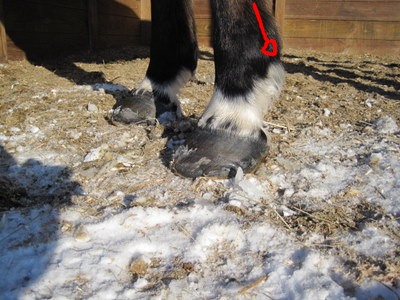
|
| Member: scooter |
Posted on Tuesday, Jan 25, 2011 - 4:58 pm: Cheryl I tell ya, if Sam wasn't such an IR PPID pain the butt, I don't know if I would have resorted to this, but after last years fiasco I thought it couldn't hurt!Hank and Sam are getting 2 scoops, Sam is a pony 14hh, Hank is barely a horse 15-15.1 hh. Flash is smaller yet and getting a heaping scoop.. approx. 18mgs. Hank has his laminitis weight... over 1000#'s and watch him cripple up before my eyes! Least I got that much figured out! I know Fox is Very much like this too. IMHO it does seem to be helping mine. I am having a VERY quiet, non starving horse winter, it's almost scary!!! Although if you read the article above or even Dr.O.'s article it suggests if your horse is obese to put them on 4 scoops and a diet until they get to a acceptable weight. SOOO since my horses aren't obese, but would really like to be, I thought this might help me through the immobile, fridgid, starve them to death, tippytoeing, I am going to die now winter  vet thought so too. It seems to be working, they aren't thin by any means, but look good. vet thought so too. It seems to be working, they aren't thin by any means, but look good. I can't wait to they shed off and see what's under all that hair!/or get shaved (Sam) I can't wait to they shed off and see what's under all that hair!/or get shaved (Sam)
|
| Member: gwenyth |
Posted on Tuesday, Jan 25, 2011 - 5:10 pm: I agree with Diane, that those of us with IR horses need to manage them so that their weight remains a constant, and this keeps the insulin in check. Management is the key, and we all need to start realizing that for MOST horses, grain is just not necessary. Grain is only for those horses that really work, and in general most people's horses really don't. I never would have thought that "just a little grain" could have so many consequences. ALL of my horses, IR or not, are off grain. I think Dr. O talks about this in great detail in his articles about weight loss.nancy |
| Member: briggai |
Posted on Tuesday, Jan 25, 2011 - 8:50 pm: Hi, all! Thanks again to all of you, you are wonderful people!Well, I DrOve 20 miles today to Orscheln's to get alfalfa pellets,called first to inquire as to whether they had them,they didn't have them! I remember Dr.O said in one of his articles to give them a small amount of high protein like calf manna. That's what I got,right or wrong. I let Butch out today,he walked right out of stall,about 1:30p.m.(no bute today) and at 5:00 p.m. when I went to feed, he trotted the 50/60 ft. back to barn to hurry and get by my mare that was acting up.Even tho he is dominant,she tries to take advantage of him when he doesn't feel well.I soaked most of his hay tonite. Set it in the sun.Got to be about 37 here today.Ordered a slow feed hay bag online today.Going to order the easy boots rx. tommorow. Okay,Nancy. you think the 10,000 mg. is enough of the mag? That is just the maintenence dose according to the container. Diane,I''ll try that DP taking. I have my doubts as to how good I'll be at that! I'm giving him a teaspoon and a half of the Thyro L. I should give him 2 then????? |
| Member: briggai |
Posted on Tuesday, Jan 25, 2011 - 8:57 pm: Diane, I don't know about Butchs'feet. I guess I don't know a bad hoof from a good one. They are not cracked/chipped. They do have some rings showing. When picked up, the soles are quite flat, not concave. They are not sloughing off in my opinion. But I don't know much. I know the rings indicate some fever. right now,under the coronet,it is growing out kind of white. Does that tell you anything? The farrier never explains much to me when he comes over. He just says, "i've seen alot worse", doesn't help me learn anything! |
| Member: scooter |
Posted on Tuesday, Jan 25, 2011 - 10:17 pm: Gail as long as he is improving I would keep him where he is. While calf manna is kind of high in NSC's he should be OK as long as you give him JUST a cup per feeding, you gotta work with what you have I am SO happy for you and glad he is improving!!!! LOL sounds like you have a very helpful farrier. Deep (Heavy) rings like in sam's hoof picture in this thread above is usually a sign of chronic laminitis, especially in EMS horses. (not always, but usually) The white is normal, the flat foot is also common in chronic laminitis, and/or poor trimming, long toe low heel, genetics. Let's tackle his hooves in a whole different thread after you get him feeling 100%... I never thought I would be doing my own horses (mostly) but HA made me LOL......... Dr.O. has VERY good articles in here about that... Hank has a flat, flared, chronic laminatic hoof... that for the most part when it is dry out is quite normal now... wet winter plays a little havoc on them and he tends to bruise and flare easily, but that is coming along slowly too. |
| Member: briggai |
Posted on Wednesday, Jan 26, 2011 - 7:59 am: Nancy, Butch is barefoot. His pasture has no grass to speak of. Some scrubs here and there,that's in the warm season! So I don't thinkgrazing has played a part in this. Today,before I order those boots, I'm going to remeasure his feet. The size chart is confusing me as to whether to go with a 3 or 4 size.How much slack can you get in those things without having them fall off? |
| Member: scooter |
Posted on Wednesday, Jan 26, 2011 - 8:32 am: They do run a little small so if he is over a 3 but not quite a 4, I would go with a 4. Be sure you measure in the right spots, that sounds like one big hoof . Better they are a tad big then too small. TOO big and they will turn. . Better they are a tad big then too small. TOO big and they will turn. When was he trimmed last? |
| Member: gwenyth |
Posted on Wednesday, Jan 26, 2011 - 9:13 am: Gail, Diane it right to ask about when he was trimmed last - you don't want to get something that will be way too big after he's trimmed...That is SUCH great news that he is moving so well, so that means you were vigilant and caught it early! IF you want to add more Mg to help the weight TEMPORARILY, you can probably give him 15g but be careful that his manure remains the same. I would think it would be OK to give him more for a month of so - it has helped my horses with weight loss, IMHO. The other thing that will work as far as protein for these horses is something called LINSEED MEAL (not oil!), as it is flax seed with the oil expressed. This is low NSC, but like the alfalfa pellets. they may not carry it. Do you have a tractor supply store by you - if you do, call them, as most of them carry the alfalfa pellets. Remember that right now you need to balance protein needs as vs weight loss, so go lighter than heavier with the protein if there are NSCs involved. Although I do not use it, I have heard that some people feed black oil sunflower seed or flax seed to their laminitic horses so that they get their omega 3 essential oils. IMHO I would NOT add anything like that now while you are trying to get weight off, but it's something to consider later when he is thinner. The other thing I forgot to mention was salt - is he getting salt other than the salt block? If not, add 1-2 Tablespoonfuls of loose (human) salt to his feed, starting gradually at first to let him get used to the taste of it. Diane knows more about this than I do - Diane - isn't it the sodium that these horses need? Some people feed iodized salt to help these horses get more iodine - since you aren't feeding any grain, you might want to try giving 1/2 iodized and 1/2 regular salt. The flat feet are a problem for these horses, and it's possible that your trimmer is not helping Butch's situation, esp if he's not eating any pasture. #1 is getting that weight off, and then #2 is getting those feet in a better form - we can help you with that, as Diane says. At least we can give you some questions to ask your farrier - lol!! Sounds as if things are improving.... and if he's walking this well already, maybe you won't need the boots? Diane, what do you think? Gail, again, you could increase to 2T thyroid temporarily to see if it helps get the weight off - just watch him closely to see if he displays any agitation or sweating which could be caused by too much thyroid, but I really don't think that adding that much should be an issue, according to Diane's experiment and the scientific literature. good luck - keep us informed! nancy |
| Member: gwenyth |
Posted on Wednesday, Jan 26, 2011 - 9:20 am: Gail, I found this online and I thought if might give you some other ideas. They suggest adding the flax seed right away - that's for you to decide......EMERGENCY DIET for laminitis Grass hay - preferably a very late season cutting of grass hay. Timothy, orchard grass and bermuda tend towards lower simple sugars and starch content.. The color of the hay has nothing to do with the sugar content. Until youʼve had the hay analyzed you should soak the hay before feeding to reduce sugars by up to ~30%, (1/2 hour hot water, 1 hour cold water), drain and feed at about 1.5%-2.0% of ideal body weight minimum (i.e. 15-20 lbs/day for a 1000 pound horse). If your horse is overweight, feed at a rate of 1.5% of his current weight, or 2% of his ideal weight – whichever is larger. Do NOT underfeed/starve the horse. Bed your horse on shavings rather than straw, as some horses will eat straw. Beet pulp – Beet pulp is used as a carrier for supplements/mineral recommendations. Rinse BP prior to soaking to remove surface contamination (Iron) until the water runs clear. Rinse it 2-3 times. Soak the BP in hot or cold water and rinse. It may take a little time for them to get used to the beet pulp. Making it a little wetter or a little dryer can help some take to it quicker, but don't give up if they turn their nose up the first few times. If you cannot soak the hay (e.g. freezing temperatures), substitute BP for 1/3rd of the hay at a ratio of 1 part BP to 2 parts hay. In other words, if you should be feeding 15 lbs of hay, feed 10 lbs hay and 2 ½ lbs of BP. Substituting BP for hay lowers the glycemic index of the diet, advisable if insulin levels are high. Because BP is more digestible than hays, it's also a good choice for the underweight horse. If horse is very underweight, substitute 1/3rd of the estimated hay requirement with beet pulp but do it on a pound for pound basis. Most horses enjoy BP but ill/stressed horses can be picky. If not well accepted, try adding one of the following: peppermint extract, beet root or anise powder, sugar-free flavorings, sage, a tablespoon or so of wheat germ, or a few hay cubes. Test your horse's level of interest in these flavorings before actually making up a batch of beet pulp you may have to throw away. Do NOT Feed - Grain Pelleted or senior feeds, etc. that contain grain products or molasses (read the label) Grass of any kind (even if it looks dead) Carrots or apples or sugar containing treats Do Feed - Iodized salt - 1 to 2 oz. a day (approximately 1 to 2 heaping Tablespoons). Regular iodized table salt added to the beet pulp is fine. Do not feed kelp. Magnesium 1.5 grams/day per 500 lbs body weight (only as a short term measure until hay analysis can confirm if it is actually needed or not, and how much). Vitamin E 1000 IU/day per 500 lbs body weight (again, human supplement may be easiest, i.e. soft gel caps added to beet pulp) Flax – 3 oz fresh ground flax seed or use stabilized flax . |
| Member: briggai |
Posted on Wednesday, Jan 26, 2011 - 11:11 am: Wow! I'm probably going to have to read this all several times to absorb it,good info.,thanks!Butch was just trimmed on Jan.4th.So he shouldn't have too much growth on his feet. Yes, I bought Stockmans salt yesterday(loose)to replace the hard salt block. Again,the only thing that Orschlen's had. Orscheln's did have a rice bran pelleted feed.Didn't know anything about that stuff? The salt package says NaCI min 95% and NaCI max.98%.Does this mean it has trace minerals in it? Hey, are you talking about weighing the hay after its soaked and rinsed, or before? Probably doesn't make much difference. Tractor supply store is an hour away from me.I will be making a trip as soon as I get a chance. |
| Member: cheryl |
Posted on Wednesday, Jan 26, 2011 - 12:02 pm: You're welcome Gail - If you use a spring scale be sure to check every now and then to make sure the scale stays set at 0 - Mine has a tendency to move down so the horses are actually getting about 5 pounds less than they should - they don't appreciate that at all We get two bales down at a time - they are placed on wooden pallets so there is about two or three feet between them - Trying to peal off hay with them up against something is not a fun thing to do. We get two bales down at a time - they are placed on wooden pallets so there is about two or three feet between them - Trying to peal off hay with them up against something is not a fun thing to do.
|
| Member: scooter |
Posted on Wednesday, Jan 26, 2011 - 12:04 pm: The weight of the hay is before soaking. I think I would get boots for this guy even if he is improving (if it's in your budget) it is better to be prepared then caught without anything I tried beet pulp on mine and the pigs Sam and Hank did not like it, Flash did, but she seemed to gain weight easily on it. I think alfalfa pellets fit in to the scheme of things better than anything at this point if you can get them. I also think if he weighs 1013 pounds at 15.1 hh he doesn't sound that obese, it does sound as if he has an EMS body and could stand to loose a few pounds and get his insulin under control. Hank is about that size and his OPTIMAL weight is 900#'s anything over a thousand and he lames up quickly. You are doing a good job  The calf manna is not something I would feed myself to these horses. Soaking his hay and weighing it is good! It will help turn him around quickly with the removal of the "hard feed" IMO The calf manna is not something I would feed myself to these horses. Soaking his hay and weighing it is good! It will help turn him around quickly with the removal of the "hard feed" IMO How is Butch today? |
| Member: gwenyth |
Posted on Wednesday, Jan 26, 2011 - 12:29 pm: Gail, I don't think you should feed your horse rice bran - too high in calories and NSCs. There are few, if any trace minerals in it - not worth dealing with. Right now think of weight loss before anything else - you could mix in a tiny bit of the calf manna if you decided to go with beet pulp. I hate dealing with beet pulp, but wanted to put that out as an option for you. I have never fed calf manna, but always thought it was for weight gain??Be sure to call the TS store before you go - ask if they have "standlee hay pellets" - they might have a number of types, but be sure they do have them before you go - that way if they don't have any, they can order you some. ... remember, you may think you are starving your horse if he isn't getting any grain, and weighed hay - trust me - they rapidly adjust and become much LESS HUNGRY once the insulin gets under control. Does he drink a lot of water and urinate a lot? nancy |
| Member: briggai |
Posted on Wednesday, Jan 26, 2011 - 12:30 pm: Hi,Diane. Butch is doing okay today.I haven't turned him out yet.Was waiting for a little sun.He's still moving slow but not near the struggle to turn now.No bute today yet,either.If he does fine today,I won't give him any tonite.I didn't at all yesterday.Ran out to barn little bit ago and tried to feel DP. Couldn't.That's either a good thing or I'm an idiot and don't know what to feel for. Diane,what do you mean when you talk about fat deposits being hard and tight? The area around his tail on his rump is soft but just below that there seems to be kinda hard tight lumpy stuff. It's all so hard with the heavy winter coat on to judge anything. |
| Member: scooter |
Posted on Wednesday, Jan 26, 2011 - 6:50 pm: Couple things I find interesting is he was trimmed Jan.4 did he become lame right after that?Does Butch have a cresty neck also? Usually if their diet is under control the "Fat lumps" become soft, they don't go away just become soft. Soft immediately around the tail head is normal that stays soft, but is also a sign the horse is or was too fat at some point. Yea I was trying to gauge my horses BCS tonight with all the hair it makes it a little tougher for sure. Sam is actually starting to shed  The other 2 are not yet, of course Sam has twice as much hair as the other 2 also. The other 2 are not yet, of course Sam has twice as much hair as the other 2 also. Here is a pic of Hank from tonight, the other 2 are too hairy too even bother to post a pic! Hank has plenty of hair, but he isn't a YAK like the other 2. I would consider Hank about a 6 BCS. I want him to DrOp at least another 50#'s before spring. The free choice hay days are over! Back to dieting. 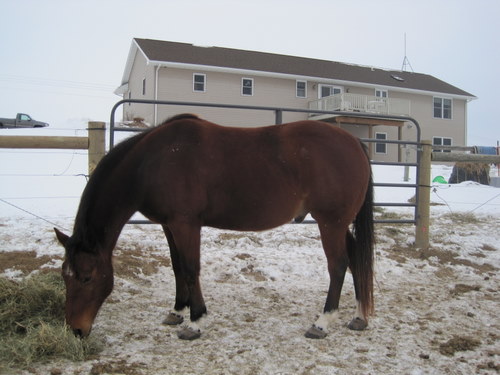
|
| Member: scooter |
Posted on Wednesday, Jan 26, 2011 - 6:57 pm: BTW Gail if you start your own thread under this EMS title, maybe with some pics and Butch's symptoms, diet, history ect. Dr.O. may chime in with his 2 cents worth. My threads get VERY long all the time LOL.Otherwise my stuff and your stuff gets intertangled and Dr.O. likes to keep things more individualized. We'll join you there 
|
| Member: briggai |
Posted on Wednesday, Jan 26, 2011 - 7:56 pm: Diane. Hank looks really good to me! No,Butch didnot get lame after trimming. Farrier did nothing radical. Butch is getting trimmed every 6/8 weeks. To tell you the truth,several days BEFORE he was trimmed, I noticed him being a little stiff and slow. I thought, oh boy,here we go. But then by the next day,he was better. Then the next day,again,noticed a little stiffness,and again seemed to be out of it the next day. When farrier came,I told him Butch was starting to slow up a little. The trim didn't seem to have any impact on him.It was the next week that,all the sudden,he was reluctant to move.I put him in right away. Diane,I turned him out about 2:00 p.m. today and when I went back out at 5:30 to feed, he stepped right out headed for the barn.Actually lifting his knees as he walked like a saddlebred usually does. I gave no bute again tonite. I ordered BOA boots today.The lady at Easy Boot took my measurements and said that a BOA boot,size 3 ,would better fit him. I ordered those. Should be here tomorrow. I'm excited! I'm thinking maybe he can go to full time turnout with these,I hope. His neck is somewhat cresty,but I'm not a good judge of these things. I was going to take pics.today but no sun. I will take pics. and start a new thread. I didn't give him any calfmanna tonite. Just a cup,if that,of his pelleted feed to mix meds on."knock On wood",this is almost too good to be true that he could be getting better already after what I went through last winter. A whole combination of changes has got to be the reason. I can tell by you and Nancy's level of commitment to your horses that you ladies are the only type of people I would intrust my horses to! Would you like to have them both???? I don't go anywhere ever. Last vacation was 1996 for five days about 5 hours away from here! Thanks, Diane |
| Member: briggai |
Posted on Wednesday, Jan 26, 2011 - 8:16 pm: I made it sound like I don't go anywhere ever just because of the horses. In all fairness, that's not the whole of it. We burn wood during the winter in our garage for 6 cats that have strayed in here over the years.Of course,I've had them all fixed! Also, I had a 16yr.cocker spaniel house dog with special needs.Just had to put her to sleep about 3 weeks ago. Then,following week had to have one of my cats put to sleep because ofsickness and massive growth in stomach.It has not been fun. I'm a real sucker for any animal in need. I don't really like to leave here because it makes me worry about my animals so much. I'm a nut! |
| Member: scooter |
Posted on Wednesday, Jan 26, 2011 - 8:44 pm: LOL Gail I'm the same way. I guess there are worse things!I think it has been 20 yrs. since we went anywhere  . We're not much for traveling anyway so it doesn't bother us. I would like to make it out to Co. to see my son and his house someday soon, but finding someone to watch all the critters is impossible. We have cows, dogs, horses, indoor cats, and not so itty bitty kiity's. . We're not much for traveling anyway so it doesn't bother us. I would like to make it out to Co. to see my son and his house someday soon, but finding someone to watch all the critters is impossible. We have cows, dogs, horses, indoor cats, and not so itty bitty kiity's. Your change in management indeed can help them that quickly. Just don't get slack with it once he feels better. I can't quite picture what Butch's body looks like he sounds much like Sam. He is lumpy all over, but his crest isn't too bad. He is the one that foundered badly last winter and is quite insulin resistant and from his hirsutism has PPID to top it off  (unless he sheds this year) which I am not holding my breath on! (unless he sheds this year) which I am not holding my breath on! I have never tried Boa boots, I am surprised they suggested them. At least you can ride in them if needed. Let us know how you like them. Boy do I understand your relief and am glad we could be of help. Just remember the next time you see that walk (hopefully never again), be proactive...don't wait to lock his butt up on soft shavings, and re evaluate. |
| Member: rtrotter |
Posted on Wednesday, Jan 26, 2011 - 8:57 pm: GailB,Your allowed to join the rest of us nuts because we all worry about our horses. Your post reminds me of my last vacation, I went because I had to, we had a free house in Las Vegas, the plane tickets were bought a year in advance. The car was booked and my husband would have killed me if I didn't go. I packed up my horses as if they were going to summer camp for a week. I went to summer sleep away camp when I was a kid and my mom had to write my name in all my clothes including my underwear. I sent my 3 horses to a turnout farm for a week and since I did not want to change feeds, I got 1 gallon zip lock bags and labeled them with my horses names and mixed their feed and the supplements specific to each horse. I loaded all the individual meals into several garbage pails and took that the the other farm. I worried about them for two days and after I called for the umpteenth time, the barn manager told me to quit worrying and the would be fine. They were, but I worried any way. The dogs went to a kennel and lived in a suite for a week, had extra play time, a pizza party and a pool party. The cat stayed home and a friend of mine took care of him and my retired old guy in the back. I would have taken him to the other farm but he gets to stressed out with any changes, better for him to stay where he was comfortable. Any way we all do strange things in an effort to make our horses lives better, hopefully our horses appreciate what we do for them. Sorry for stealing your thread Diane. Take care Rachelle |
| Member: scooter |
Posted on Wednesday, Jan 26, 2011 - 9:04 pm: Rachelle I know you just want me to have a part two LOL, it's been awhile BTW I saw something interesting the other day and thought of you. They are something like hoof casts with shoes? I think they are new, they have cuffs...sound familiar at all? I'll look and see if I can find them again |
| Member: lilo |
Posted on Thursday, Jan 27, 2011 - 9:29 am: Gail - don't feel bad - you can tell we all make our animals safety and welfare a priority! I only have the two horses when we go away - and possibly my daughter's two cats, if she comes with us.Fortunately my neighbor and riding companion now does animal care for a fee - I would trust her with my critters for sure. Besides - she can see my house and barn from her house, making it easy to keep an eye on things. So - maybe this year we will make that much postponed trip to New Mexico to check on our property down there. Lilo |
| Member: gwenyth |
Posted on Thursday, Jan 27, 2011 - 10:47 am: Gail, it is possible that the flat feet being bruised could look like laminitis, but IMHO I would consider that he HAD laminitis and treat accordingly - if you see Dr.O's advice about bruised feet, it is very similar to recovery from laminitis - better safe than sorry for sure...I think you are seeing good results because you noticed his soreness and did something about it - AND reducing his calories is only going to help his recovery. Glad all is going so well, and I know that I can speak for Diane and the others that we are so happy to help you, since many of us struggled with this, too. The more support we have during these crises, the better, I think! I had some terrible troubles with my one horse this summer, and got some great support here on HA> Keep us updated as to his condition. nancy |
| Member: briggai |
Posted on Thursday, Jan 27, 2011 - 5:38 pm: Hi All! I posted some pics.of Butch today on thread BCS 7/8. Take a look and tell me what youthink? It has taken me hours to do this.My picture program on my computer would not allow me to size the pics.down. It took me forever to find another software and learn how to do this.Yuk!!! Butch doing well today. I'm going to check and see if UPS brought his BOA boots. Can't wail to get them on and see if they fit. Gail |
is The Horseman's Advisor
Helping Thousands of Equestrians, Farriers, and Veterinarians Every Day
All rights reserved, © 1997 -
